#Zasulauks
Explore tagged Tumblr posts
Photo

Esi tramvajs, Kas pret miglu Cīnās Un uzvar. #1tramvajs #RS57103 #Zasulauks #Rīga #Latvija #2017 #Tramvajs #tram #tramspotting #publictransport #traffic #migla #fog #Škoda #15T #RīgasSatiksme #picoftheday #instadaily #ig_riga #ig_latvia (at Latvijas Universitātes Botāniskais dārzs)
#rīga#2017#ig_latvia#instadaily#tramvajs#rs57103#tramspotting#tram#rīgassatiksme#picoftheday#1tramvajs#migla#fog#škoda#15t#zasulauks#ig_riga#traffic#latvija#publictransport
0 notes
Photo

Zasulauka kultūras nama paliekas (at Zasulauks) https://www.instagram.com/p/CbDNTcVsMlo/?utm_medium=tumblr
0 notes
Photo

Aizlidot sapņiem līdzi #Zasulauks #Rīga #Latvija #2017 #nature #butterfly #tauriņš #ig_riga #ig_latvia #picoftheday #instadaily (at Latvijas Universitātes Botāniskais dārzs)
0 notes
Photo

Tramvaju rakumi #1Tramvajs #Zasulauks #Rīga #Latvija #2017 #Tramvajs #tram #publictransport #architecture #urban #104 #traffic #construction #RīgasSatiksme #Škoda #15T #ig_riga #ig_latvia #picoftheday #instadaily (at Latvijas Universitātes Botāniskais dārzs)
#2017#zasulauks#publictransport#1tramvajs#rīgassatiksme#picoftheday#construction#104#škoda#tram#architecture#latvija#urban#ig_riga#ig_latvia#traffic#instadaily#tramvajs#15t#rīga
0 notes
Photo

Tu neraudi Par tiem laikiem Senajiem, Kad te satiksmes ceļš Uz Jūrmalu gar logiem Bija ierīkots. Tu neraudi Par tiem laikiem Senajiem, Kad bija citādi, Jo katras pārmaiņas Nes arī ko labu. #Zasulauks #Rīga #Latvija #2017 #architecture #city #urban #Čehu_projekts #streetscape #ig_riga #ig_latvia Vecā Jūrmalas gatve ir daļa no senā ceļa uz Jūrmalu, kas tika izbūvēts, attīstot Imantas dienvidu apbūvi, jo līdz tam Slokas iela, senākais ceļš uz Jūrmalu, jau bija pārāk šaurs, līkumains un nevajadzīgi garš. Padomju gados izbūvēja jauno Jūrmalas gatves pārvadu, tolaik garāko satiksmes pārvadu pār dzelzceļu Latvijas teritorijā, līdz ar to satiksme tika pārcelta pār to, Veco Jūrmalas gatvi atstājot vien kā pievedceļu privātmājām un vēlākajos gados izbūvētajām daudzstāvu ēkām. Mazās mājiņas pie pašas ietves vēl glabā kādreizējo sajūtu. (at Imantas Tilts)
0 notes
Photo

Don't go What we have here is irreplaceable No, I won't trade this for nothing I may not ever get my shit together But ain't nobody gonna love you better Than me #25trolejbuss #Zasulauks #Rīga #Latvija #2017 #Trolejbuss #trolleybus #busspotting #publictransport #traffic #city #urban #streetscape #architecture #plattenbau #467 #instadaily #picoftheday #ig_latvia #ig_riga /MØ ft.Snakehips - Don't Leave/ (at Latvijas Universitātes Botāniskais dārzs)
#city#ig_riga#25trolejbuss#trolejbuss#instadaily#urban#plattenbau#trolleybus#streetscape#ig_latvia#zasulauks#busspotting#picoftheday#traffic#rīga#467#2017#latvija#publictransport#architecture
0 notes
Text
Tweeted
🇱🇻 Ugunsgrēks trīs stāvu ražošanas ēkā Kandavas ielā #Zasulauks #Rīga #Latvija.https://t.co/Jp3vlxIamp
— BreakingLV (@breakinglv) November 27, 2020
0 notes
Text
Neighborhood #12: Āgenskalns
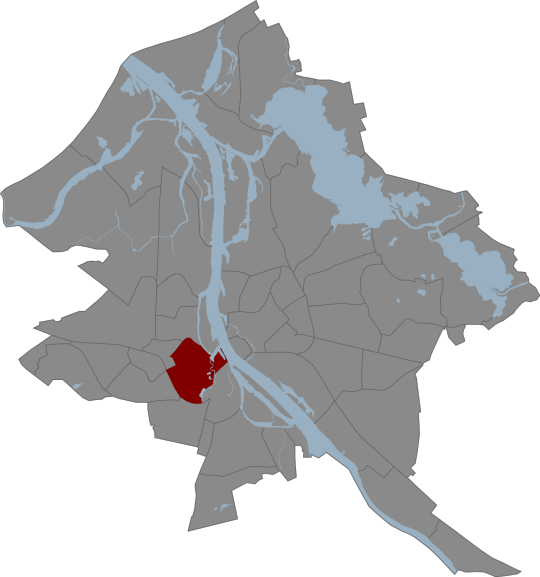
Name: Āgenskalns Meaning: Translates roughly to “Agens Hill” Area: 4.61 km2 (27th) 2014 Population: 27,923 (9th) 2008 Population density: 6538 people/km2 (11th) Distance from Riga Central Station by public transit: 8 minutes (train) Public transit lines: #3, #4, #4z, #6, #7, #8, #13, #20, #21, #25, #38, #39, #47, #50, #51, #52, and #55 busses; #1, #5, #9, #11, #13, #18, #22, and #23 trolleybusses; #2, #4, #5, and #10 trams Places of interest: Kalnciema Kvartāls, Uzvaras parks (Victory Park), Āgenskalna tirgus (market), Māras Dīķis, Alises torņis (water tower), Date of Visit: March 18, 2016
Last month we visited the cultural hub of the Pārdaugava region: Āgenskalns. One of the city’s most well-known and instantly recognizable areas, nearly anyone who has ever crossed the Daugava river to the city’s western half has been through at least a bit of the neighborhood, as two of the city’s four bridges cross into it. From Vecrīga, it’s just a five-minute walk across Akmens tilts (stone bridge).
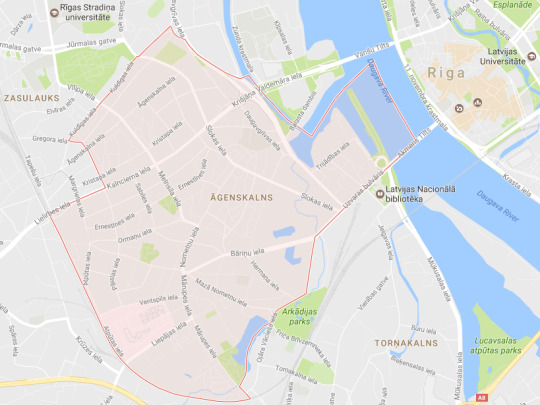
While the Rīga-Tukums line makes for a logical southwest border and the rivers clearly cut the neighborhood off from the rest of the city, the other borders seem a bit arbitrary and fuzzy. This is even more apparent when looking from above. Many people refer to a much greater area than just that in the red lines as “Āgenskalns,” while others might consider much of that northern area above Kalnciema iela part of of Zasulauks.
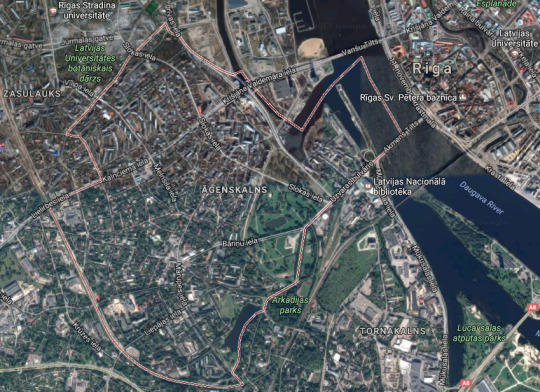
The good news was that we would be exploring Āgenskalns with our friend Konstantin, a life-long resident of Rīga with an encyclopedic knowledge of the history of the city’s buildings thanks to many hours spent researching online and in the city’s archives. Even better, he’s from the neighboring region of Zasulauks just to the northwest, so he was able to provide us with particularly generous wealth of information about Āgenskalns. The bad news was that the only day that him, Līga and I could all go together happened to be the one rainy day in a string of otherwise perfectly sunny and relatively warm days. While Konstantin’s philosophy was that this part of Rīga looks good even in gray and drizzly weather, I feel a bit bad that we weren’t able to do this beautiful neighborhood justice with such dreary backdrop.
Līga was a bit busy earlier in the day, so I met Konstantin by myself first to check out the area by the river before she would join up with us a bit later. I got on a #3 bus from the station and took it just two stops before getting off at the Nacionalā bibliotēka (national library) stop where I met up with Konstantin.

We started on towards the river, walking first by a beautiful pinkish pre-war building that Konstantin told us was used by the Soviet government as a teacher training academy. Apparently during Soviet times teachers were not required to have a university-level education, so it was something more akin to today’s trade schools. To the immediate left was what looked at first like a newly renovated pre-war building until Konstantin told me about the interesting history behind it. Apparently it was a derelict abandoned building before Latvia hosted the EU Council presidency back in early 2015. Since the library across the street was to be used to host dignitaries throughout the six months, the city ordered the owners to give the building a facelift, resulting in a freshly painted skeleton. I couldn’t believe this until we got closer and I was able to see inside for myself.
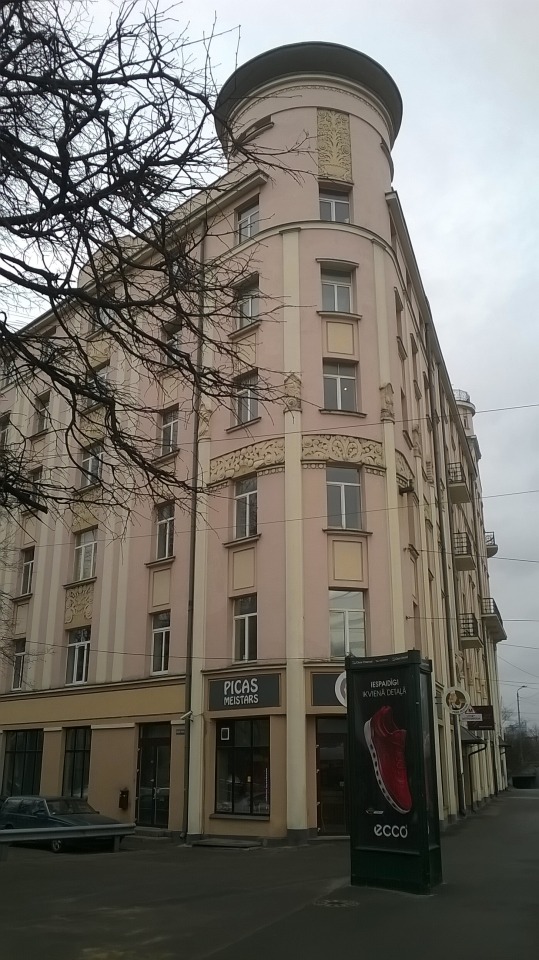


It’s inconceivable to me that this prime real estate so close to the river and tram lines had not been properly renovated by some savvy developer, but there are many other situations just like this throughout the city. Across the street was a somewhat unusually decorative Hruščovka with an interesting brick pattern. I might not have mentioned it previously, but one interesting thing about at least the brick version of these Soviet projects is that the year is usually inscribed at the top using differently colored bricks.

Continuing down the road, we came to an abandoned old police station across the street from a 90s-era housing construction. As is the problem with nearly any city in the world, it was sad to see such a beautiful structure fall into a state of disrepair which at this point would probably prevent it from being reconstructed in an economically efficient way. Its juxtaposition across from those modern condos were a bit poignant in illustrating how preservation can be lost as an urban priority.



Just a bit further on, we crossed onto the AB Dambis, a large jetty first constructed from wood in the 1880s to regulate the Daugava's flow and for loading and unloading boats. The structure was destroyed by the German army during WWII before being reconstructed in its current form by the Soviet army. If you're interested in learning more about it's history, you can check out this post from Cita Rīga (in Latvian, but can be translated). We walked out to the furthest point and took a few pictures of Vecrīga's skyline and of where we would soon be walking in Āgenskalns.
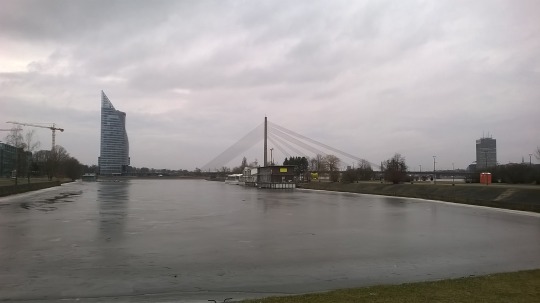



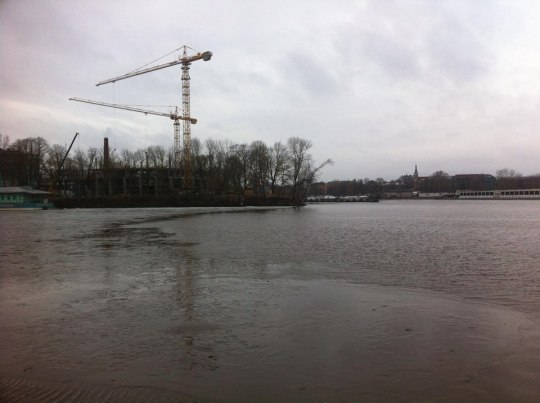
I got a call from Līga who said that she would meet us soon at the same libary bus stop where I had met Konstantin, so we started heading back in that direction. After waiting about ten minutes at the bus stop, we finally met up with Līga and started down the gray brick road of Valguna iela. To get there we passed under a concrete residential building which like a few others in the neighborhood had been constructed over the road itself. According to Konstantin, this was an “experimental” residential project which was not replicated due to its uncomfortably cramped living conditions and non-intuitive navigation on the inside. Along this road were a row of Stalin-era buildings on the left and some older wooden ones on the right.
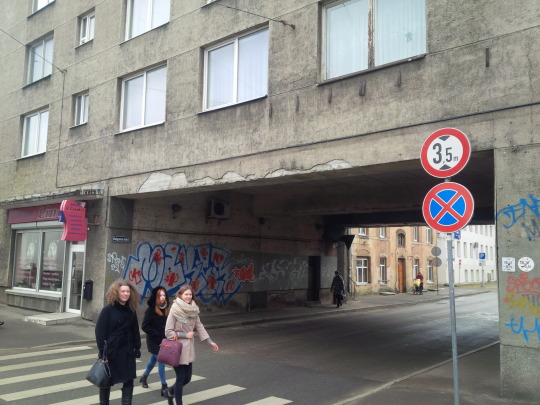
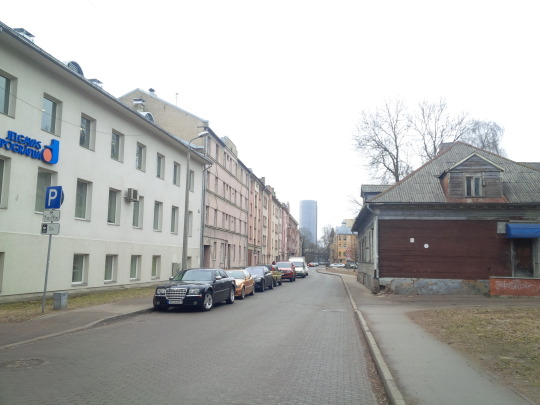
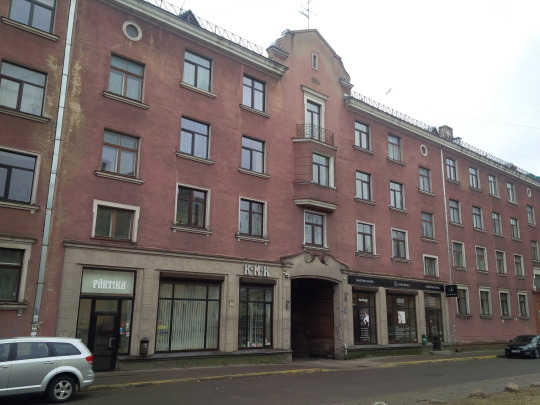
To our right there was a building which Konstantin pointed out was built on top of what had previously been part of Staraja Rusas iela, one of the only remaining streets in the city with a Russian name. While it's no longer officially part of that road (at least according to Google maps), it was interesting to see that some history-conscious person had written the name of the street above the driveway to preserve its memory. We also passed a what seemed to be somewhat nightmarish pre-school/kindergarten, along with a fairly scary balcony.
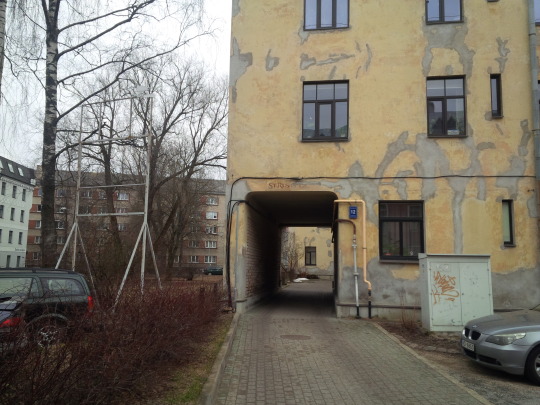


We came to the end of Valgumu iela, and before turning right onto Trijādības iela, we saw what Konstantin said had been a riverboat repair facility before being abandoned. We walked down Trijādības iela towards the river, seeing on our right a typical back yard with trees benches that are very commonly seen next to buildings built in the first half of the 20th century all the way up until the end of Stalin's time. A graffiti ghost on the wall seemed worried or upset about something; maybe we had gotten too close...



Unforunately we couldn't get any closer to the river since the construction area we had seen from AB Dambis was gated off, but Konstantin pointed out one very interesting building before we left. I wouldn't have noticed it on my own, but the two-story house was built in the traditional Latvian style that can be seen throughout the countryside, with the roof slanting on all four sides. Generally these houses are made of wood, so it was a bit unusual to see one here made of brick, further adding to my impression of Āgenskalns as one large architectural gallery. We passed by Latvia's sea administration and a modern apartment complex before coming again to the abandoned riverboat factory as well as a row of very typical brick hruščovkas and another scary-looking kindergarten.
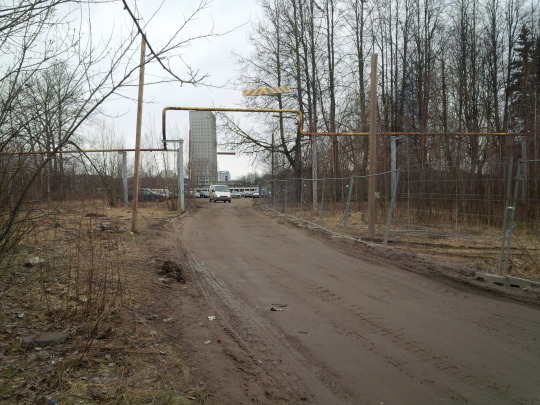



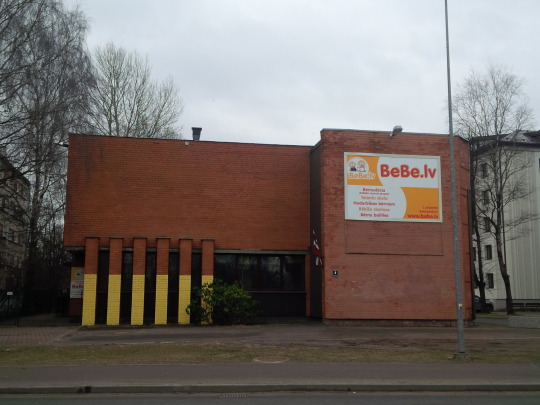
We took a right onto Raņķa dambis, which quickly turned into Daugavgrīvas iela. Although winter was more or less over, the cove of Zunds canal still had a thin layer of ice covering it. We got a good view of the old riverboat repair factory with some Latvian graffiti on the side and then saw some modern riverboats being repaired right in front of our eyes. Since there is no longer a dedicated facility, a man was standing on top doing some welding right in the open on the deck. We also passed my favorite place in Rīga to drink outisde during warm weather months, Piķis un Zēģele, a relatively cheap pub with a deck overlooking the water. If you're ever here in the summer months and love to sit back and relax outside with good, reasonably priced beer while watching boats go by, definitely check it out.
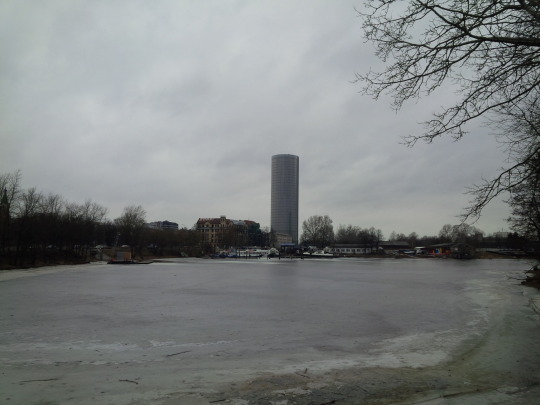


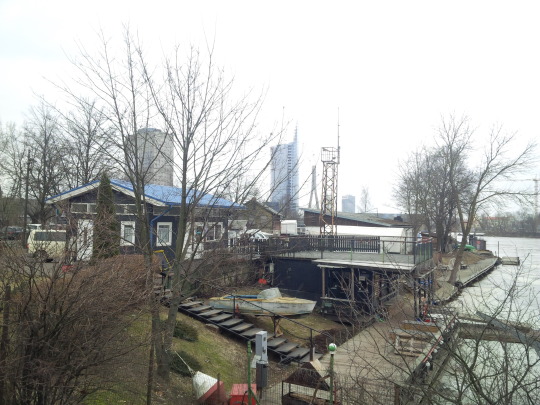
Just across Daugavgrīvas iela from the road to Ķīpsala, Konstantin pointed out a beautiful pre-war building which used to be a polyclinic for children and teens which unfortunately was now in such a state of disrepair that it had no floors. To the right was another beautiful pre-war building which was derelict aside from the first floor, this one having a commemorative plaque for Latvian composer Pēteris Barisons who had lived in the house before WWII. A brick hruščovka next door ws in much better condition, and had a variety of stores on the first floor including what looked like a tasty vegetarian restaurant.

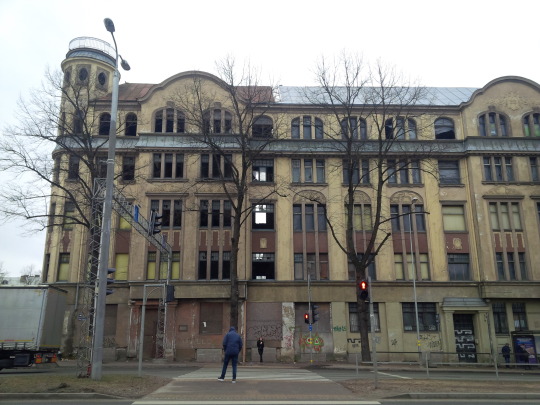
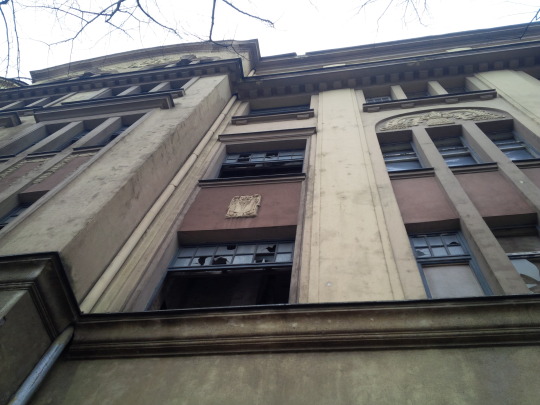
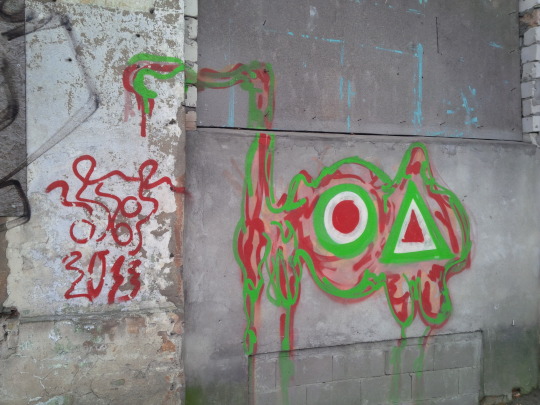

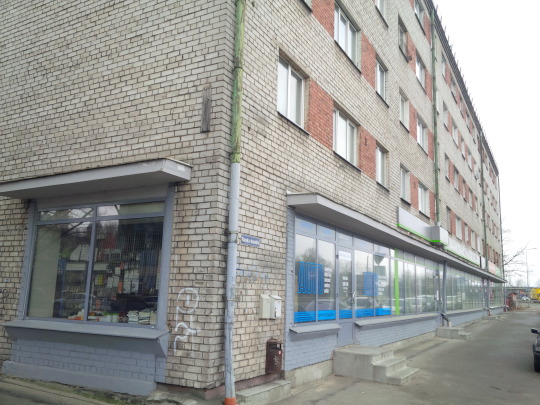

And now we were finally at the base of the infamous “Z-Towers” which had been visible from many previous neighborhoods. As I mentioned briefly in the article about Dzierciems, these troublesome twins had been under construction since 2006 and were conceived in a different era of urban planning just before the 2008 crisis where this area around Ķīpsala was planned to be a sort of financial district for the city and many other similar large buildings had been planned. As it is, it's almost a small miracle that these ones got finished at all. The buildings began sinking not long after construction since engineers had failed to compensate for the marshy ground beneath, and had to halt progress and improvise a new technique for drying out the foundation. The death of a construction worker whose harness tragically failed stopped progress for even longer, and the buildings went through multiple exterior and interior design revisions as it was being constructed to help make it more more economically feasible. As a result, the final minimalist and utterly generic result is a far-cry from the original gaudy and bombastic structure that was originally planned.
First planned to be an upscale hotel in one tower and offices in the other, now the majority of units in both towers have been marketed as luxury apartments of various sizes. Until 2014, it was possible to receive a five-year Latvian residence permit with full access to the EU and a path to citizenship for a property investment of as little as 70,000 Euros. Although parliament bumped that up to 250,000 Euro due to concerns about Latvia's property market being exploited as a massive money-laundering mechanism by international criminals, I'm sure that foreigners with an interest in accessing the European common market should have no problem finding a unit worth a quarter of a million in these glass behemoths. On one hand these towers further justify Āgenskalns' reputation as an architectural mecca, but at the same time even for this neighborhood they stick out like Siskel and Ebert's thumbs banged with a hammer by a bitter director. While it's easy to dismiss them as yet another tacky monument to the anonymous global 1%, I like to think of them as a relic from a more optimistic time in the city's history when the sky seemed the literal limit for ambitious developers just before it fell in spectacular fashion just a short time later. For more information about the history and future of this ongoing saga, check out this incredible thread on skyscrapercity.com which has been documenting the building's progress over the past ten years.
When we tried to get up close to the buildings, a security guard at the gate predictably banged on the glass and yelled at us to get lost. We were still able to get a nice look at the impressive structures as we hung left onto Krišjāņa Valdemāra iela and started up the hill towards the northern part of the neighborhood.

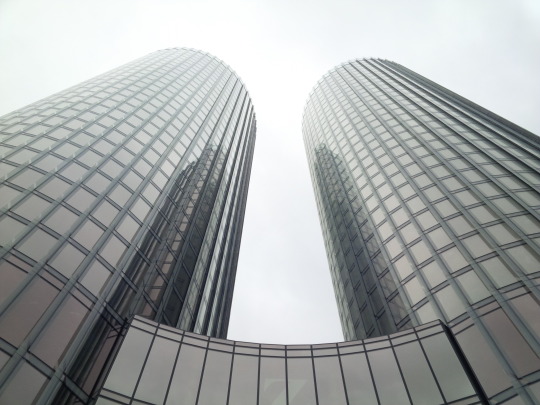
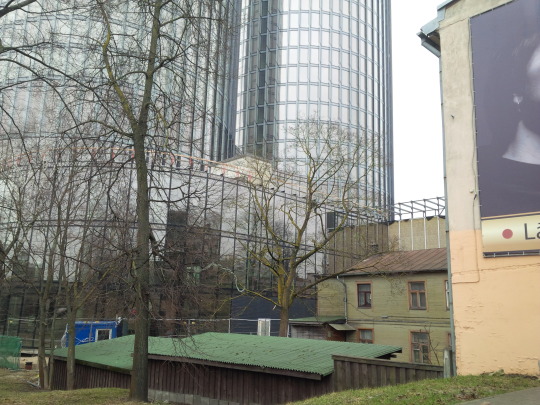
While the same can be observed in pretty much all of the city's more central neighborhoods, the clash between “old” and “new” is especially striking here. Aside from the obvious example of Z-Towers, this street was lined by a mix of small pre-war wooden houses, concrete and plaster early 20th century buildings, and glass and steel constructions which look like they had been dropped off by a visiting UFO.
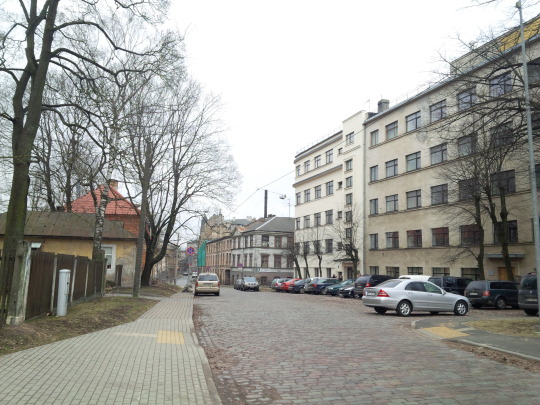


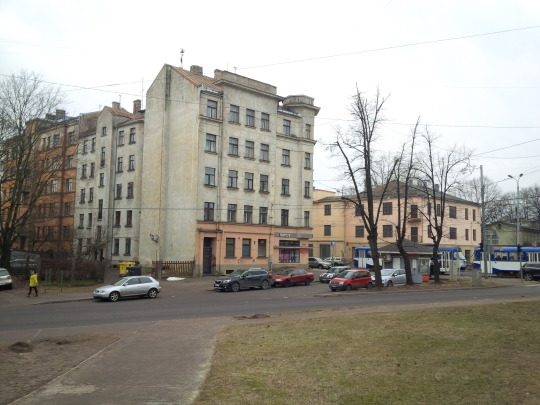

So far, this had been our route since we had met Līga near the library:

We now started down the major thoroughfare of Slokas iela, coming up close to one of Konstantin's and my favorite looking buildings in the city: the national historical archives. I'll let the pictures speak for themselves in terms of how awesome this building looks. The archives are free to browse, but professional photocopies to be brought home cost a fee. Luckily, scores of benevolent history fans have uploaded a lot of material contained there for free to various forums and websites. Much of the information contained there is in Russian due to that being the lingua franca and official language of the Soviet Union, so proficiency is required for serious browsing/research. Documents from 1920-40 though are mostly all in Latvian.
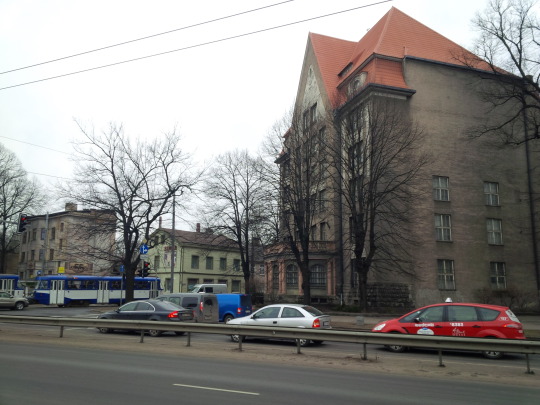
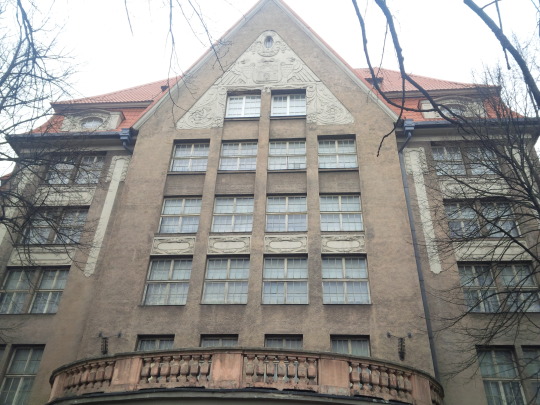

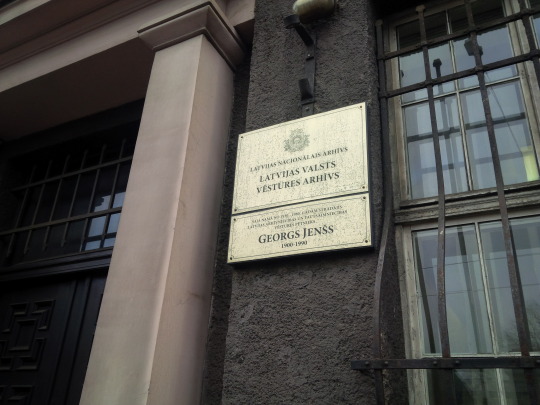

Slokas iela contained a nice mix of older wooden houses and Rīga's famous art nouveau buildings from the early 20th century. On one of the buildings, we found a subtle but interesting historical relic. During Soviet times, all of the street names were written in both Latvian and Russian throughout the city. After regaining independence, the government began replacing them with newer, Latvian-only plaques. On this particular building instead of replacing the entire sign, someone simply painted over the Russian version of the signage which had been found on the bottom of the sign. The result was surprisingly effective, as I never would have noticed if Konstantin hadn't pointed it out to me. We walked left down Mārtiņa iela and then left down the offshoot of Daugavgrīvas iela. No matter how far we walked away from them, Z-Towers loomed behind us.
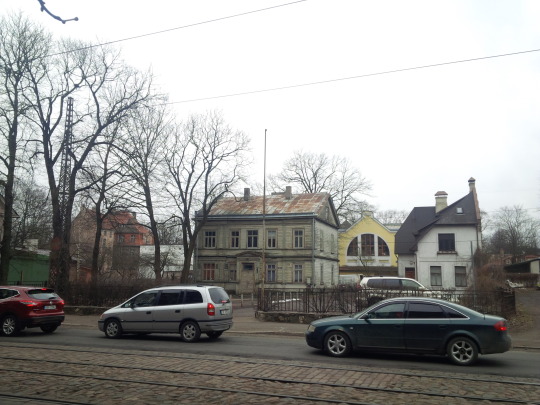
Jugenstils (art nouveau)
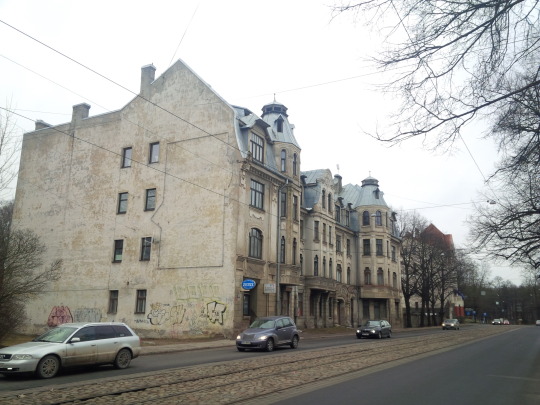

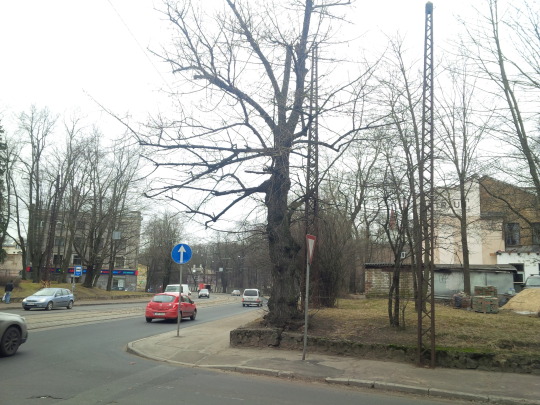
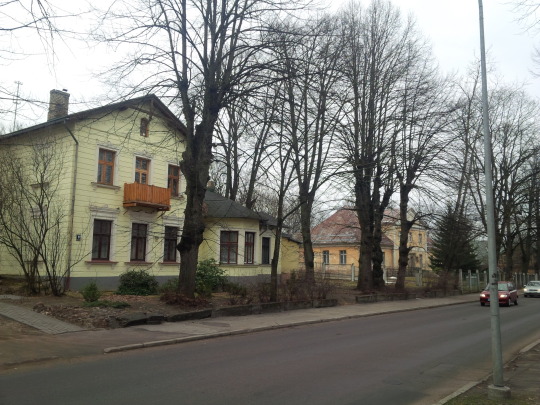

And now we came up to one of my many weird civil planning-related obsessions: a ghost ramp! These “roads to nowhere” are offshoots of other roads that are built to connect with a future transportation project that for one reason or another never quite materializes. This particular one was intended to connect with one of the many aforementioned projects intended for the Ķīpsala area before the bubble burst in 2008. If Z-Towers are a semi-living monument to the pre-crash era of naive optimism and big thinking, then this ramp is something like a poignant and symbolic memorial. I was excited to finally have an excuse to go onto this ramp that I had passed so many times before on my way to work, and from it we had a nice view of the tall buildings as well as the former territory of a factory that built farm machinery just underneath where the ramp is now. We also got a view of the northern edge of Āgenskalns where we were headed next.
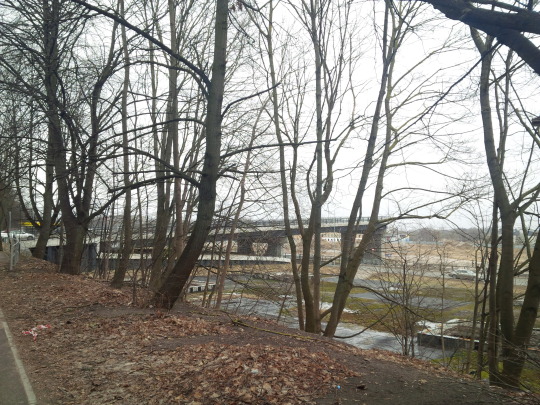
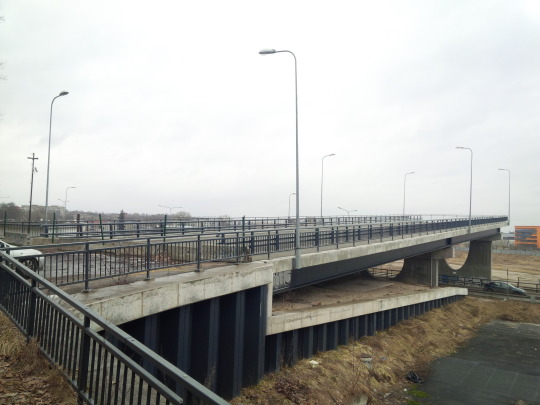
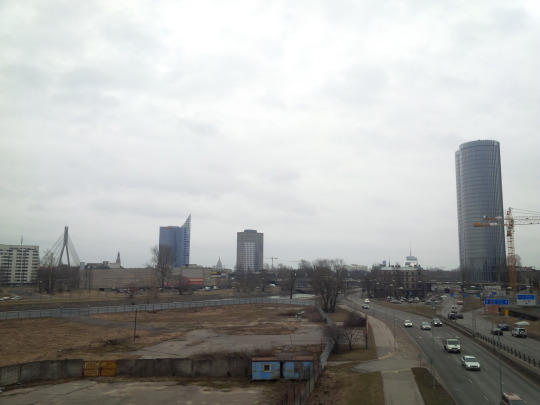

We walked towards Mārtiņa Evaņģēliski luteriskā baznīca (St. Martin's Church), passing two older art nouveau buildings: a current police station to the left, and an apartment complex with a classical-style sculpture out front to the right. When we got to the church's back yard, we took the path through crossing back to Slokas iela. The Romanesque church was built in 1851 and 1852, and the red twin steeples are visible from most of the northern part of the neighborhood. Konstantin pointed out the odd fact that the lantern is built in such a way that it can be lowered using a pulley.
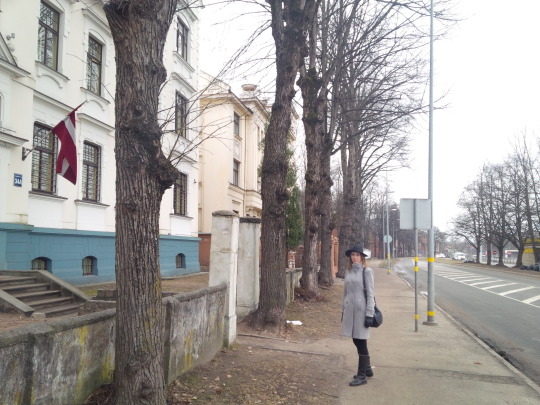
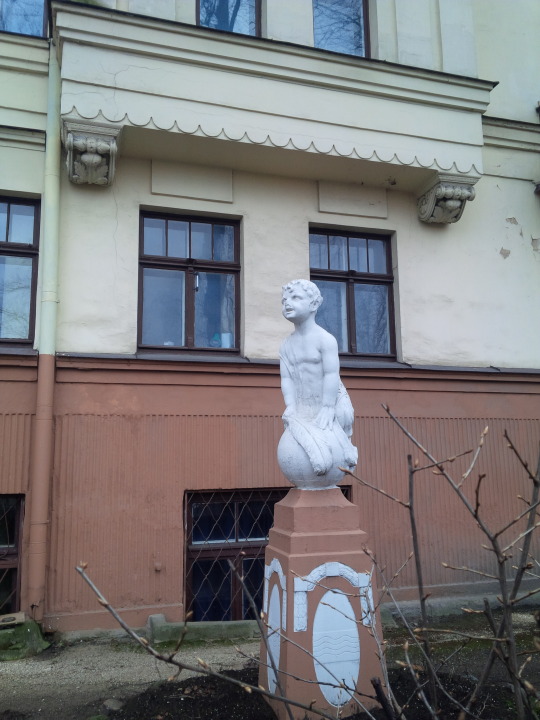
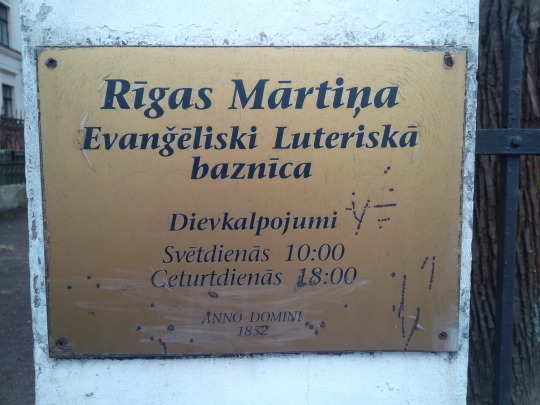
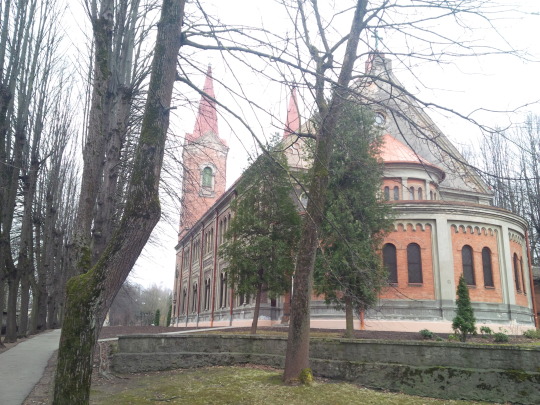

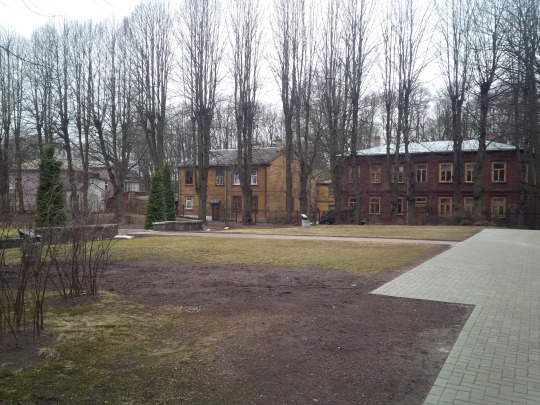
lowerable lamp

Coming out of the church yard and turning left onto Slokas iela, we passed a cool purple wooden building and a music school before coming to the nearly-abandoned Mārtiņa kapi (St. Martin's Cemetery). Many of those resting in this graveyard have no living relatives to maintain their graves, although we could see a few modern tombstones that distant descendants had bought for their long-departed ancestors. Following the tram line down the street we also passed the very modern purple courthouse before we turned right down Kuldīgas iela.
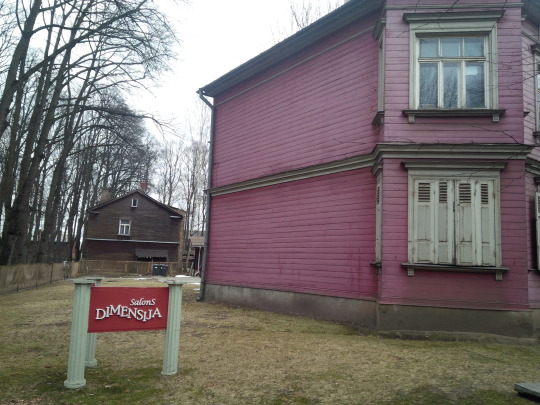

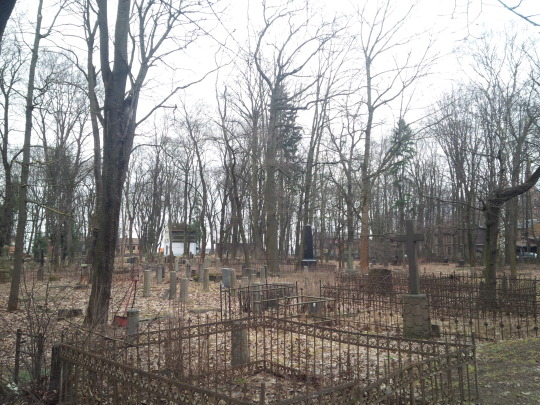
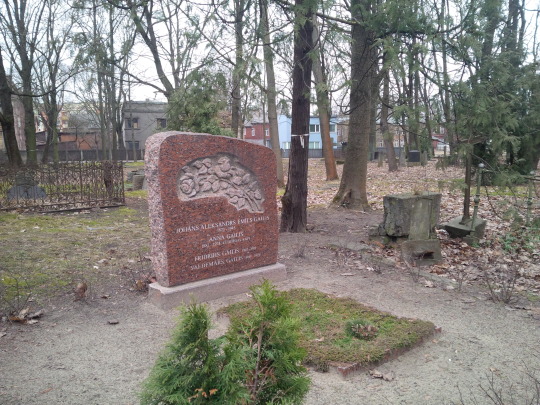


Just as we were turning left down Kuldīgas iela, we saw a plot of land adjacent to the botanical garden that seemed like it was part of the garden's territory until Konstantin explained that it was actually a private plot in the process of being sold. That explained why it had the old-fashioned wooden fence while the rest of the garden had a much newer metal one surrounding it. Signs of spring were everywhere as we continued down the street; people were raking up leftover leaves now that the snow had almost all melted, and small flowers were starting to bloom here and there. When we came to busy Vilpa iela, we turned left and came to Rīgas Valsts vācu ģimnāzija (State German Gymnasium), one of the city's oldest high schools founded in 1921. During months when leaves are on the trees, the school is hidden from the road except for the wooden “window” which you can see in the first picture of the school. Unfortunately, at this time of year the effect gets lost.
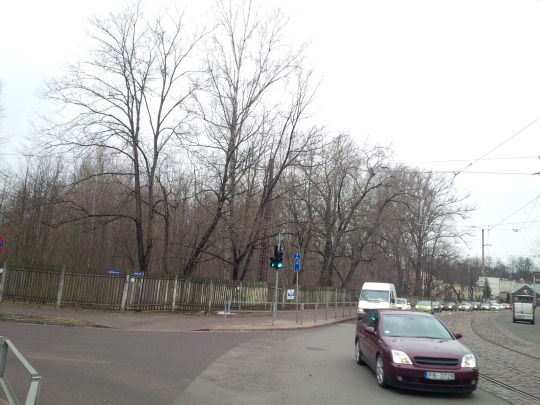
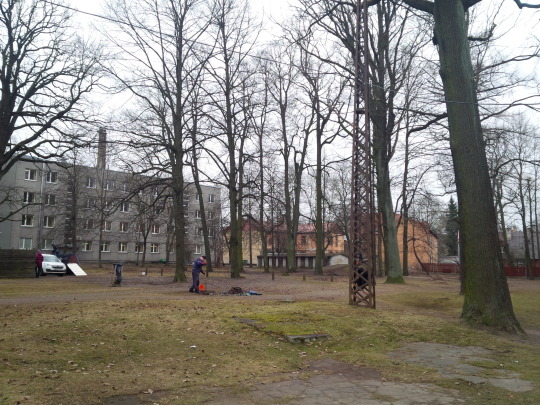
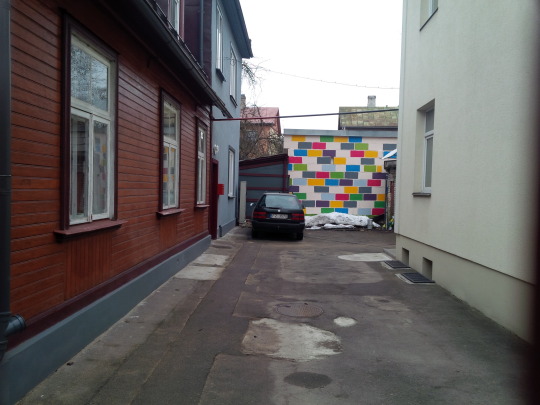
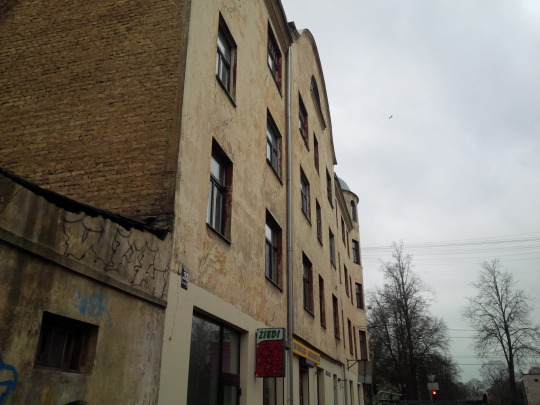
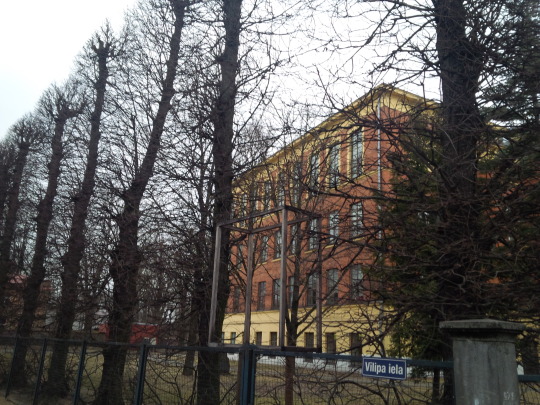
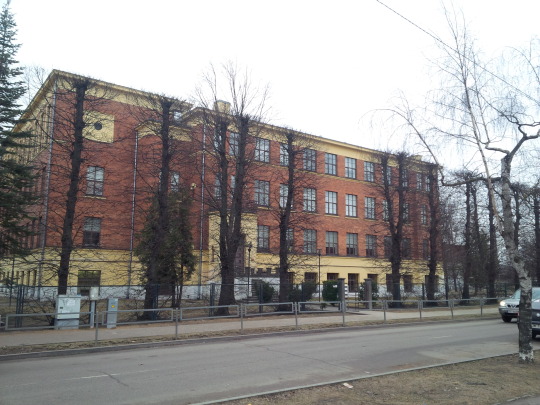
At the corner of Melnsila and Āgenskalna ielas, we found what Konstantin explained was called “Āgenskalna Priedes” (Agenskalns Pines). This early and experimental “micro-district” that the Soviets constructed in the late 1950s was the first of many often much larger projects in the further-out neighborhoods of the city which were constructed all the way through the 1980s. These concrete-panel buildings are some of the first very early hruščovkas to be built in the city in response to the post-war housing crisis that was only exacerbated by Stalin's obsession with ornate, decorative buildings which took too long to construct to meet the population's needs. Konstantin told us that while these buildings look to be in good condition from the outside, many have problems with electrical wiring beneath the floors that were not properly installed during the original construction.
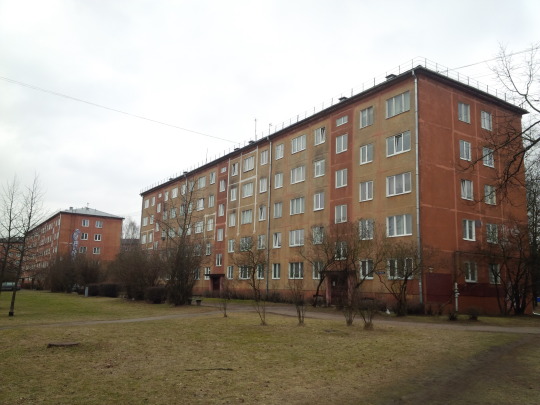



This housing project also has one of the last Soviet-era playgrounds to not be torn down to to safety concerns. The metal playground equipment you can see used to be ubiquitous throughout the city's suburban districts, but since independence the city has mostly favored removal over renovation. The building you can see in the background looks new, but is actually a recent renovation of a pre-war building. Seeing the potential of what could be if more of the city's gorgeous old structures received the same love and attention only makes it sadder to think about many of the other buildings' current states.
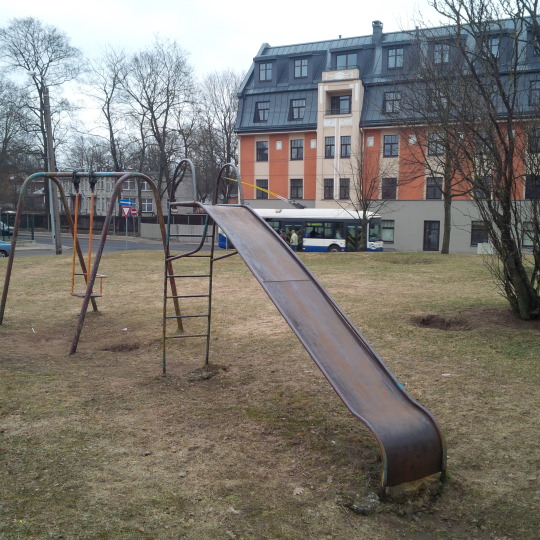
From the background of the development we could finally get a great view of one of the neighborhood's most famous landmarks: the water tower named “Alise” Yes, believe it or not, some of the city's gorgeous water towers have these kinds of names. After this particular one stopped being used for its original purpose due to introduction of more modern distribution methods, the building was used as an underground record label/studio until the late-2000s. The owner of the Coffee Tower chain and a few other bidders tried to buy it, but the city deemed it a historical monument before it could fall into private ownership. Hopeful the city will maintain and find a good municipal use for this beautiful landmark, as the building really is a stunning piece of architecture.
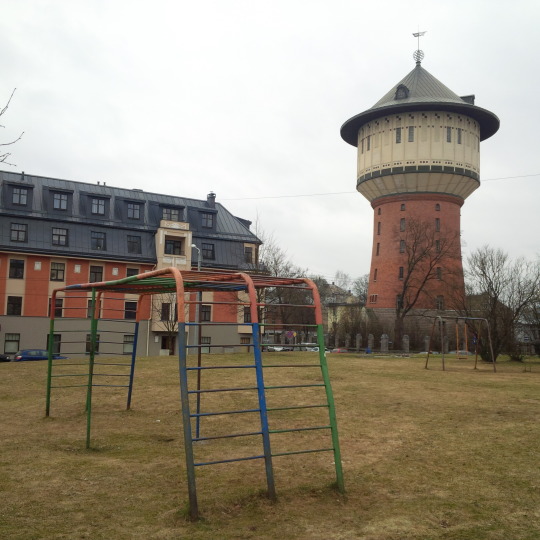

We turned back onto Melnsila iela and passed a wooden building with a store called “Alus pagrabiņš” (which translates to something like “Little Beer Basement”), a store which sells unusual and hard-to-find beers both on tap and in bottles. People often buy large plastic bottles of the beer straight from the tap so that they can bring it home and drink later, which is usually cheeper than buying glass bottles or cans.
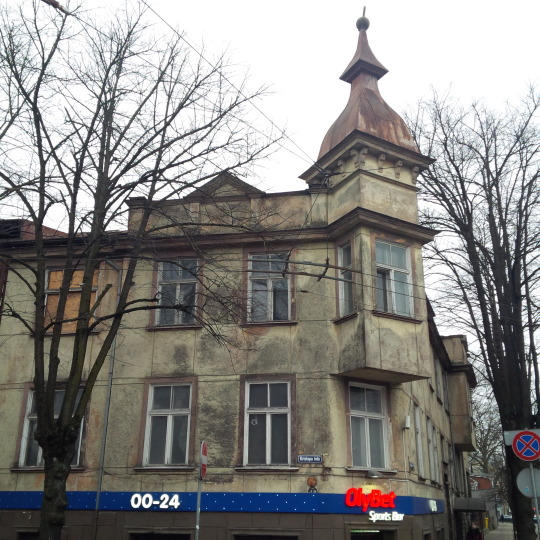

Now we came to the famous “Kalnviema kvartāls” (Kalnciema Quarter), a group of wooden buildings on the corner of Mensila and Kalnciema ielas. One of the most well-known enclaves of the city's “creative class,” the mini-district features various shops, galleries, offices, and performances spaces, and hosts many cultural events including a weekly Saturday market in the main yard between the buildings. We regretted not being able to come here a day later to check out the market, but I would strongly encourage visiting it if you can make it out here on a Saturday. For any of you who are fans of good wine, there's also a fantastic wine shop and cafe open every day except Sunday from 10-22.
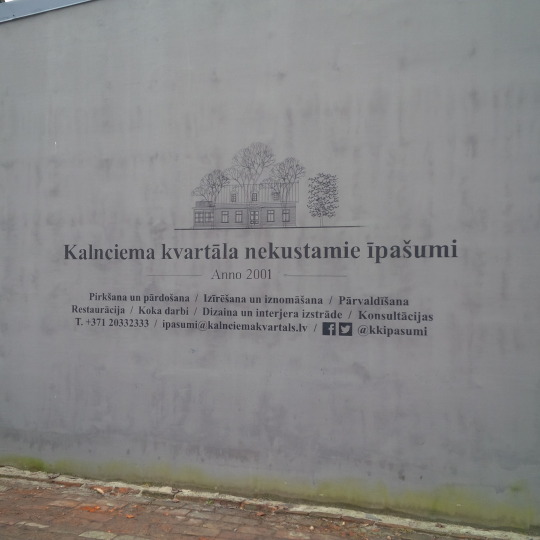
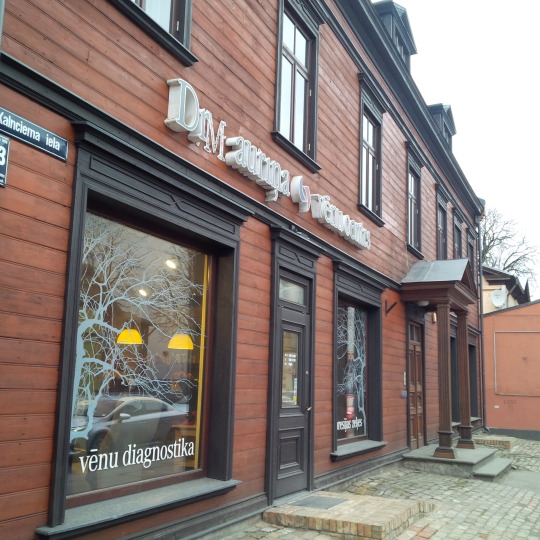

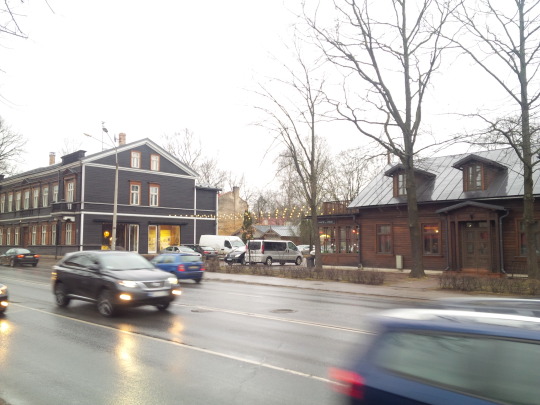
We were pretty hungry at this point, so Konstantin suggested that we try a kebab place called “Fix Box” which he had passed many times before but never actually tried. The interior was modern and colorful, and the prices seemed fairly reasonable so we decided to give it a shot. The wrap was toasted and crispy, which was a bit unusual for Riga's kebab places as they usually wrap them in softer shells. Overall the kebabs were pretty good, but I'm not sure it was mind-blowing enough to recommend coming all the way from the center for considering the wealth of options there to try. If you're in the area and love kebabs though, I doubt you'll be disappointed.
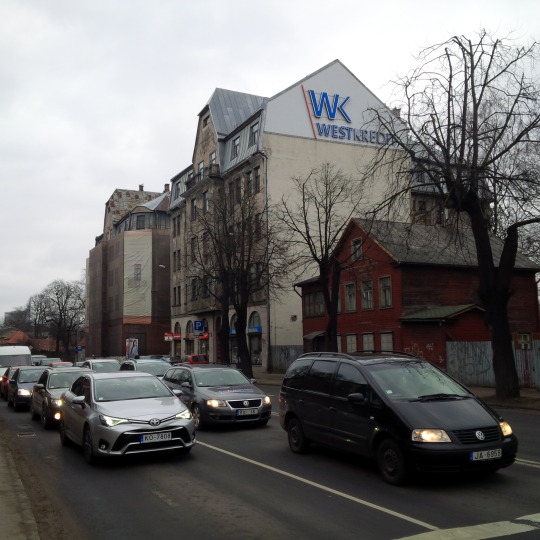

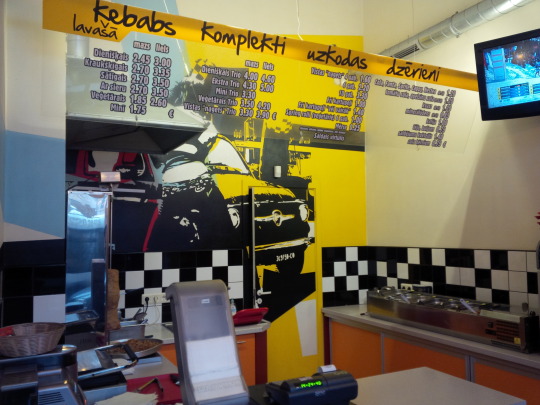

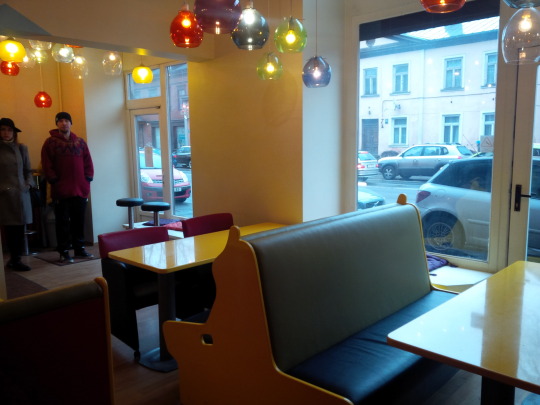

Since the ghost ramp, here is more or less the path that we had taken to the kebab spot:
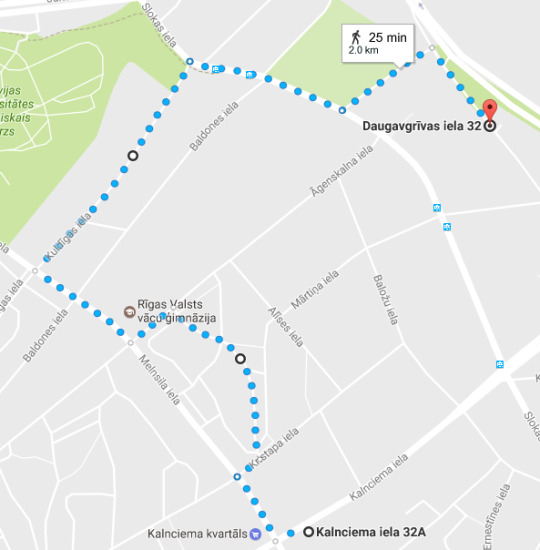
As we left our lunch place, the weather began to take a turn for the worse that would gradually only worsen. Undeterred, we continued southwest down Kalnciema iela before hanging right onto Sabiles iela. Down this street the mishmash of modern and older architectural styles continued, although in this part of Āgenskalns most all of the buildings didn't reach more than three stories tall. Konstantin pointed out that the dilapidated green building at the end of the road had been “somewhat renovated” on the very right side, which is not uncommon for some of Riga's older buildings in such condition considering that many such buildings have multiple owners. A lot of the older wooden houses throughout the city are split into halves or even quarters depending on the size, and this can be reflected sometimes in the buildings' visual appearance.
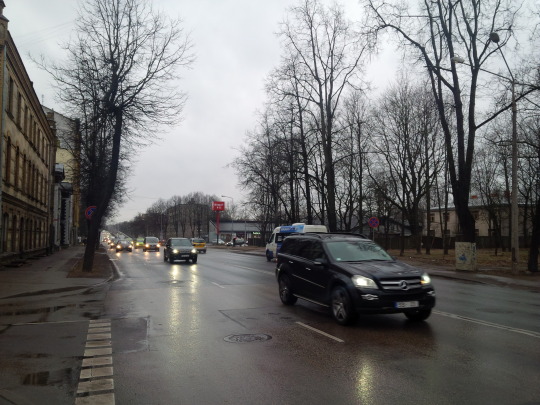
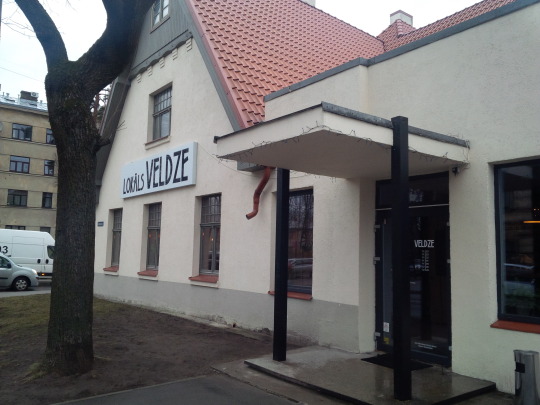


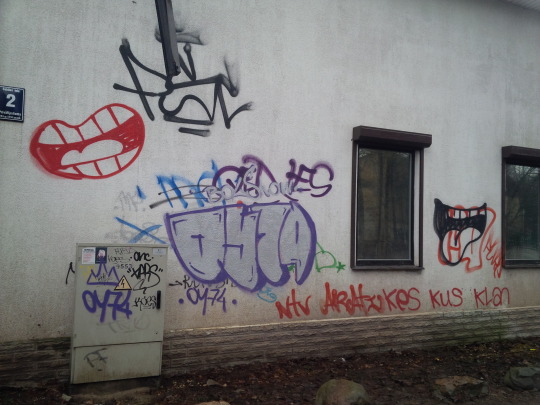

At this point, Sabiles iela turned into Talsu iela, and we continued on towards the more urban part of Āgenskalns. Right at the start of Talsu iela I saw one of the coolest yet strangest-looking houses I've ever seen, which seemed as if the architect was torn between three different styles and chose all three. A bit further down the road, we got a glimpse at the old TV tower. Before moving to is current headquarters on Lucavsala in the middle of the Daugava, Latvia's Television used to be headquartered in Āgenskalns, and used this tower to broadcast. According to Konstantin, the city has deemed the tower as a “dangerous object” and has ordered it to be repaired immediately. Regardless of its perilous state of repair, the tower still currently broadcasts Radio Merkurs on 1485 kHz (AM).


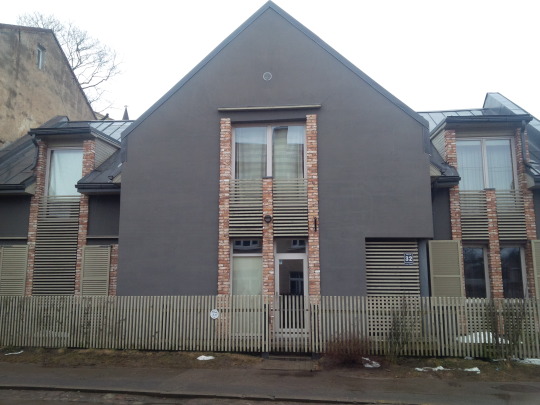


We turned now left onto Nometņu iela since Konstantin wanted to show us a few different buildings this way. We found a sad wall that was either bemoaning street litter or had very low self esteem. A bit further down we came to the first of the buildings that Konstantin had mentioned, a “communebar” called “Hāgenskalna Komūna.” He told us that it's the best place this side of the river to hear small acoustic concerts, although various DJs also play sets. Apparently they also offer a good selection of food and drinks, so we plan to check it out sometime soon.
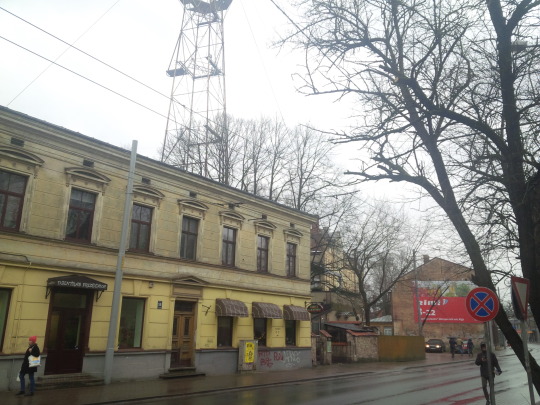
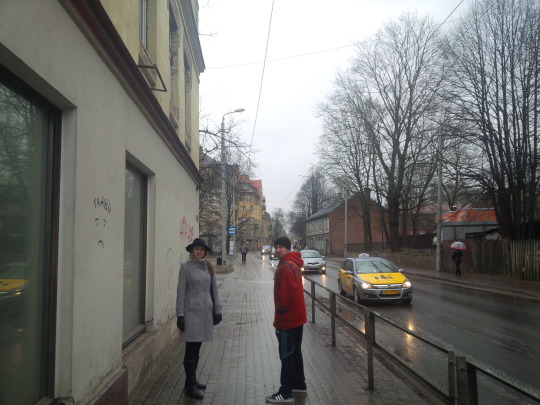

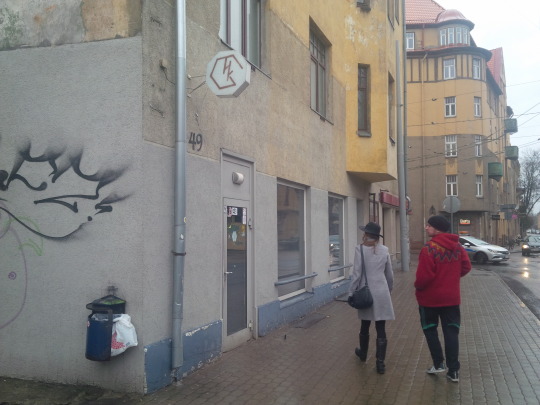

Just past the corner of Lapu and Nomeņtu ielas we came across the scariest-looking balconies on the planet, which were all missing floors. They were (barely) attached to one of the coolest-looking buildings in the entire neighborhood, a strange castle-shaped one over which there is a dispute as to which architect designed it. Apparently two people claimed to have drawn the original design. Next we found what is a very popular trend in America but something I had so far yet to have seen in Latvia: former cinemas converted into evangelical churches. The first was a brown Art Deco-ish one on the left which now hosts the “Dzīvā Ūdens Avots” (living water source) Pentecostal Church, and the second was a tan-colored one just down the street which is inhabited by the “Jēzus ir Kungs” (Jesus is Lord) evangelical church. The second was offering an “alpha course,” a basic introduction to Christianity that was popularized in the UK but can now be found all over the world.
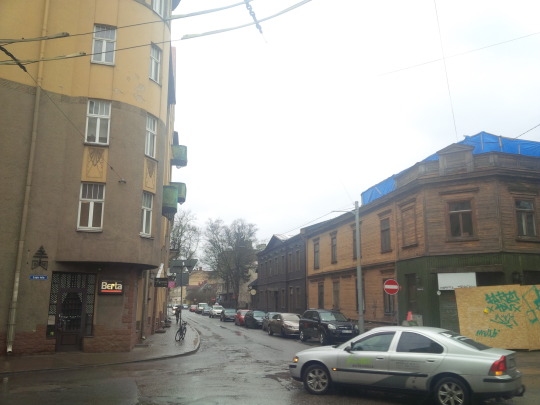
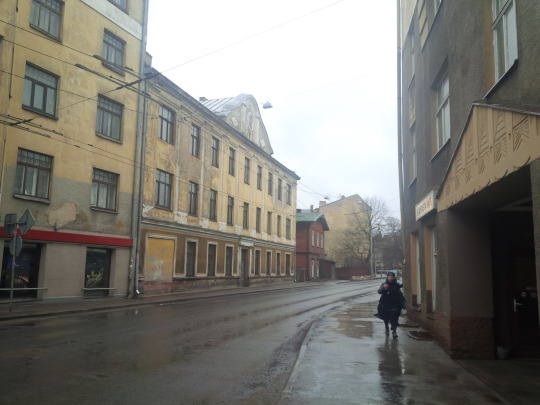
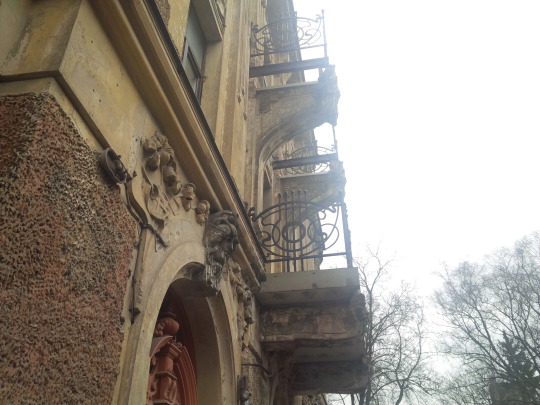
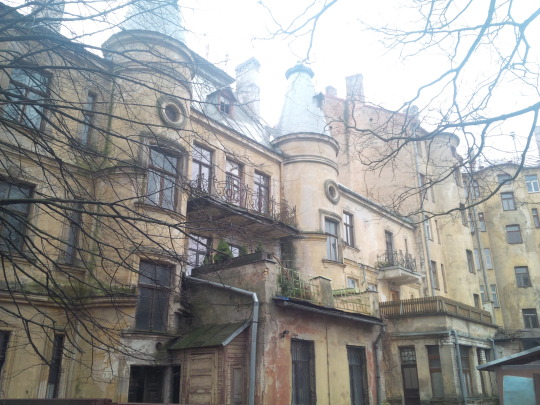
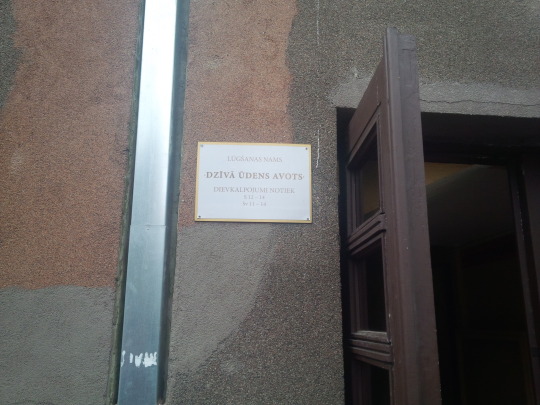
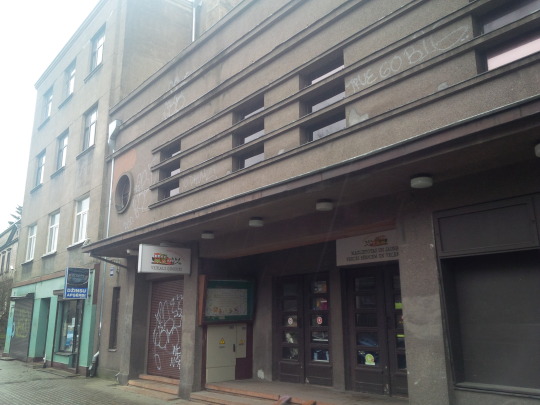


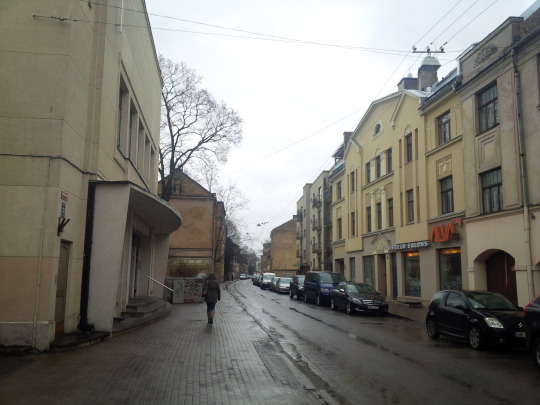
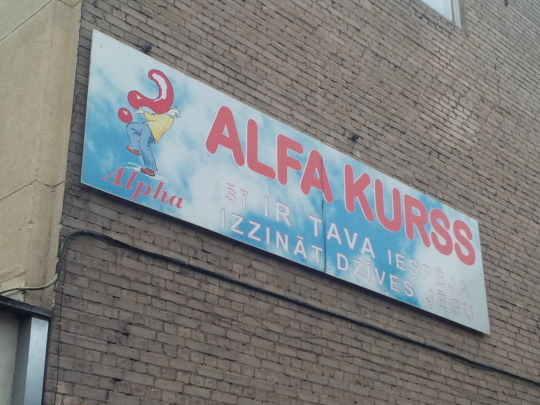
Continuing down the street, we saw more wooden and brick buildings from various eras. Shops included a fancy-sounding “brick salon” (yes, a salon in which you buy bricks), a door and window ship, a pizza place, an upscale restaurant, an antique shop, and another location of one of Līga and my favorite cafes in the city: Ciemakuklis, which we visited in Dzirciems last year. At the intersection with Slokas iela we took a left.
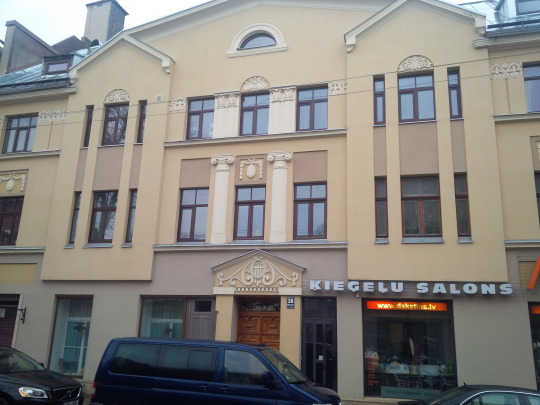
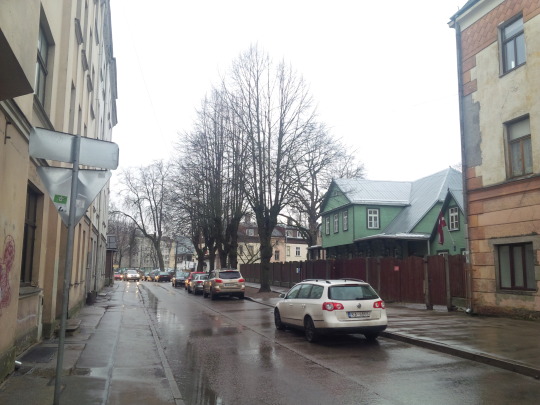

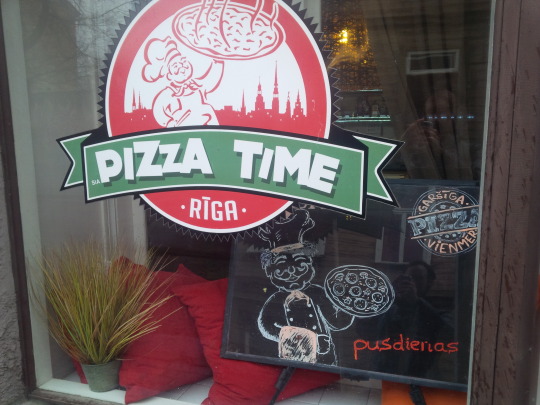

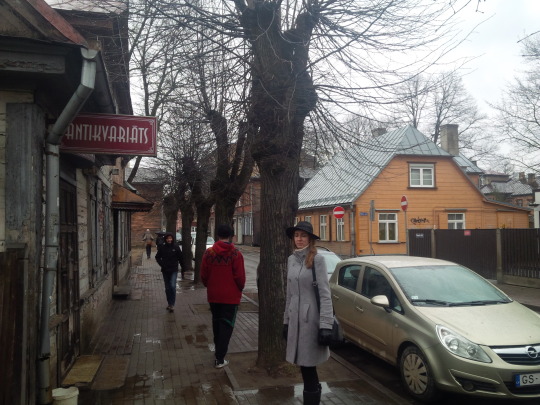
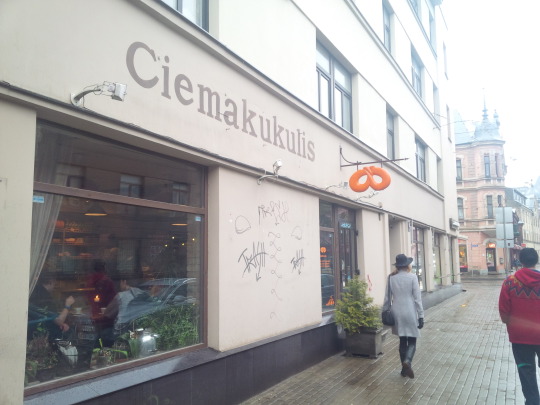
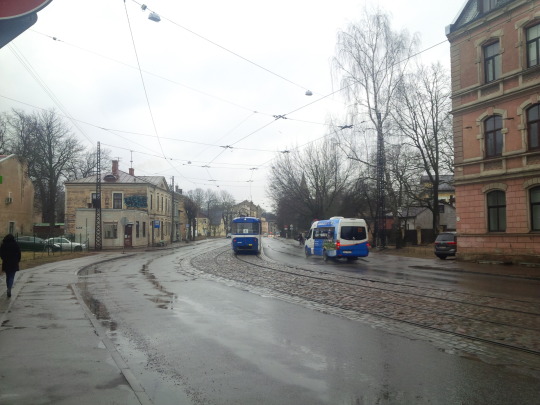
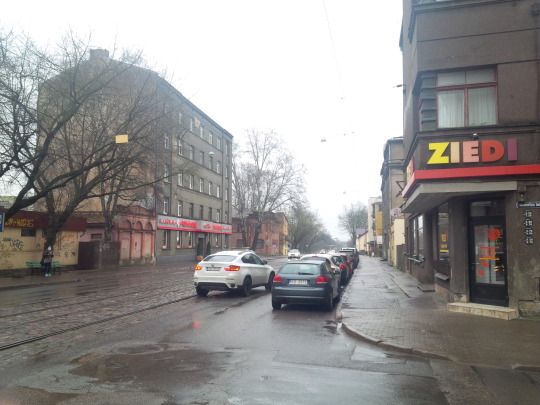
On Slokas iela, Z-Towers once again reappeared and loomed in the distance. We walked first by a church called Latvijas apvienotā metodistu baznīca (Latvian United Methodist Church), one of the few methodist churches in the country. Next door was an old white building which Konstantin said used to be used as a wedding registry. He told us that his parents had registered their marriage there, and that they were sad to see it become derelict throughout the years. We were just about at the corner of Slokas and Kalnciema iela again where the state archive was, so we took a few pictures and then hung left down Ernestīnes iela back towards the market square.

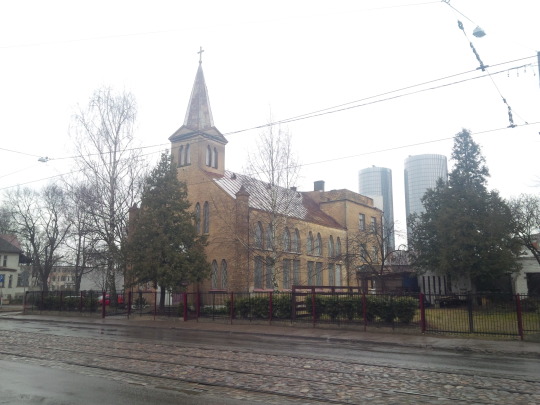


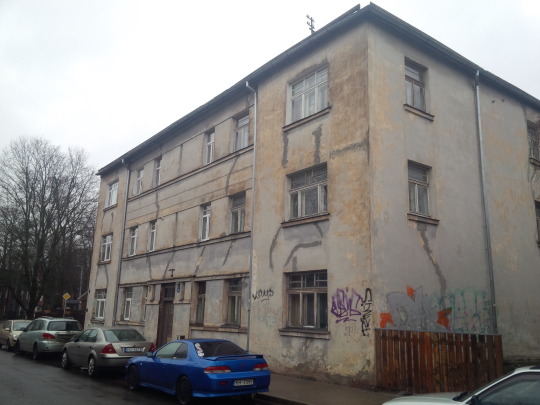
Ernistines iela cut through yet another district of short, wooden houses, but this part of town contained some of the city's most well-known schools. The first was Rīgas Dabaszinību skola (Riga School of Natural Science), a UNESCO-affiliated youth education center that puts on various workshops and activities related to natural science. The gate looked open and we wanted to take a look through the school's grounds, but we opted against it. Across the street was the well-regarded Āgenskalna Valsts ģimnāzija (Agenskalns State Gymnasium), a high school that is consistently ranked in the country's top five in terms of exam results and student achievement. The third we passed was the newly renovated Rīgas 53. vidusskola right on the corner of Ernestine and Melnsila ielas.


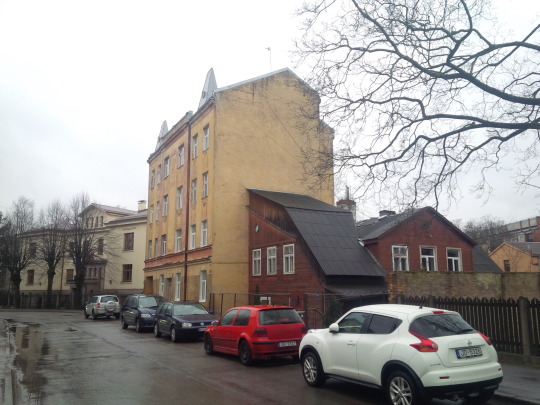
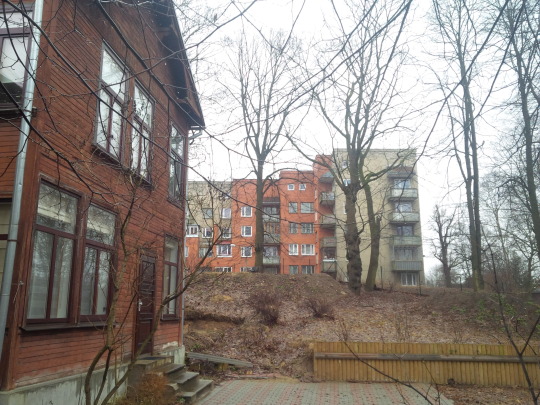
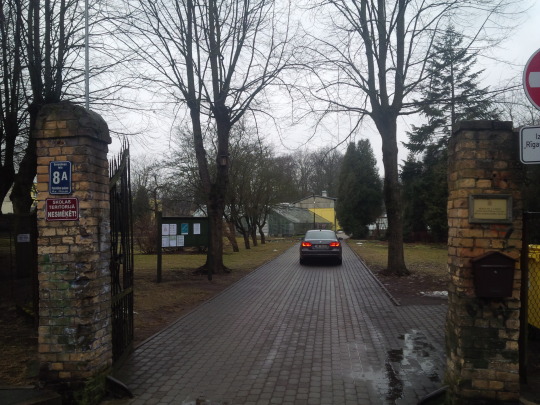
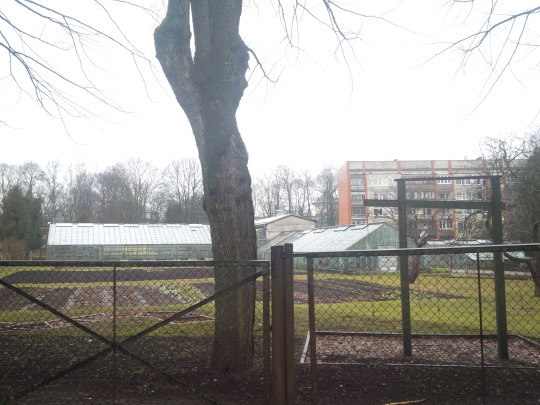
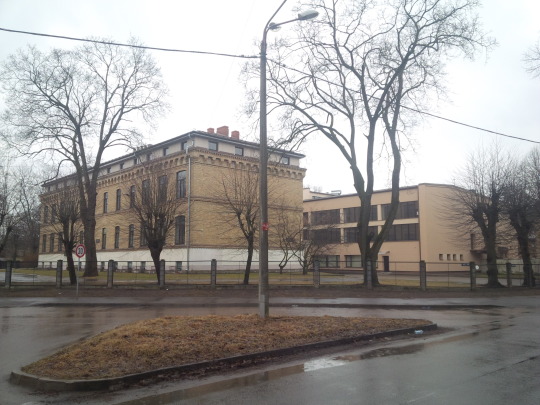


As we turned left back onto the larger road, we saw a car driving by with some large metal piping tied dubiously onto the roof. This reminded me of how in my home state of Maine it’s not uncommon to see pickup trucks on the highway with large stacks of various items tied precariously onto the bed, and how its occasionally necessary to dodge them when they fall out onto the road in front of you. We followed Melnsila diela back down to Nometņu iela where we took a right and started heading toward the market.
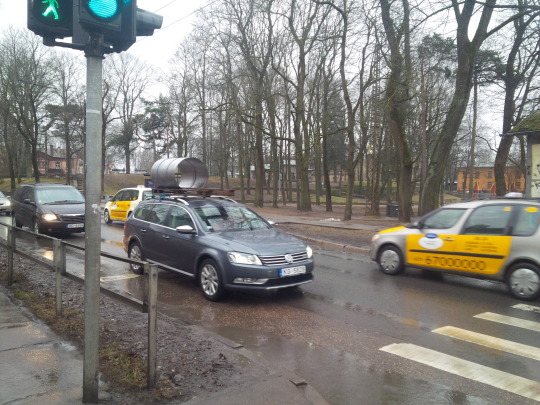
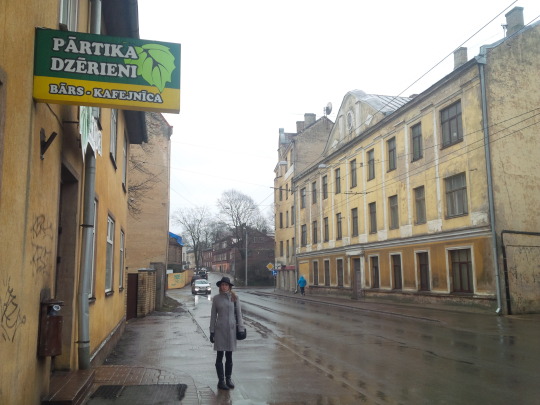
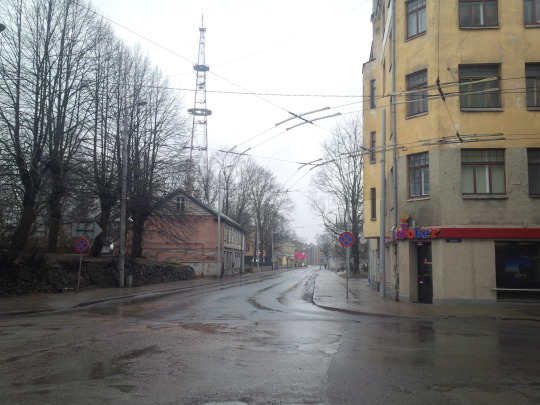
Since leaving the kebab spot, we had walked in this very strange spiral-shaped path:

On our way to the market we passed by one of the city's rare food trucks as well as two cafes situated next to the old tower. It's a bit hard to see from the picture, but one of the tower's supporting guy wires had been decorated with colorful ropes. Konstantin told us that the SEB building (one of Latvia's most popular banks) used to be taller, but that the top floor had been removed during renovation to help make the building more sturdy.
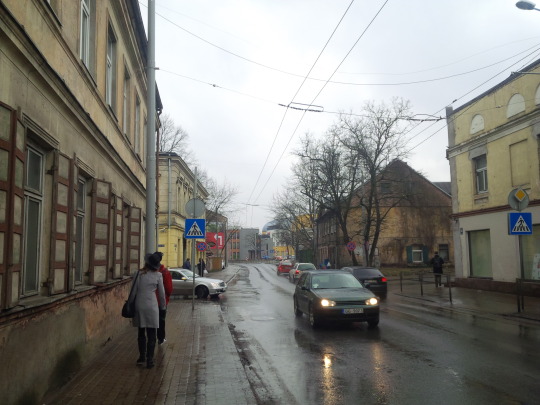

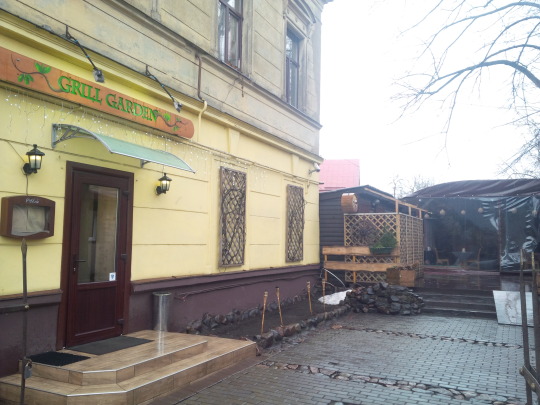
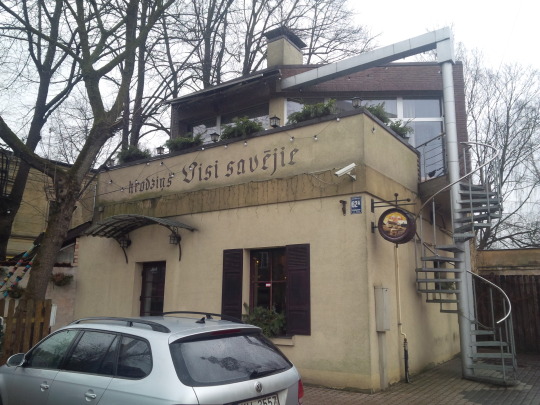

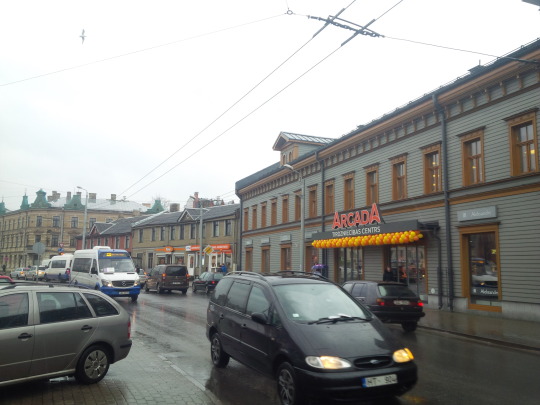
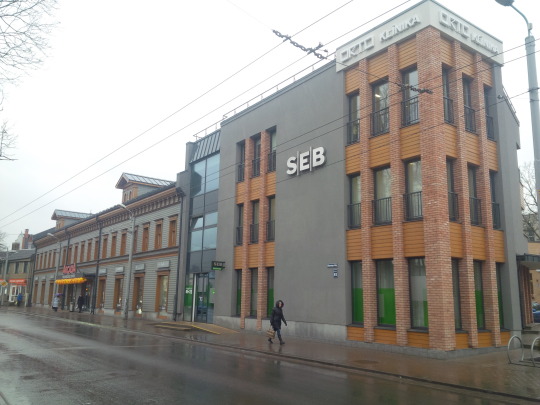
In the market square there were a bunch of posters for a theater event called “Obama Bananas Go,” which according to one of my friends was some sort of abstract high-concept comedy show that had nothing whatsoever to do with former President Obama. While I was shocked at first and am sure that the poster would have not only been taken down within hours but also sparked outrage if it were posted in the United States, Latvia has so few people of color that conversations about race are nearly non-existent and some of my students even have a hard time understanding why they can't use the n-word even though they hear it often in rap music. That doesn't stop me from trying to educate my students about these issues as much as possible and doing my small part in improving this situation, but I'm not as shocked by this sort of thing as much as I was when I first came here.
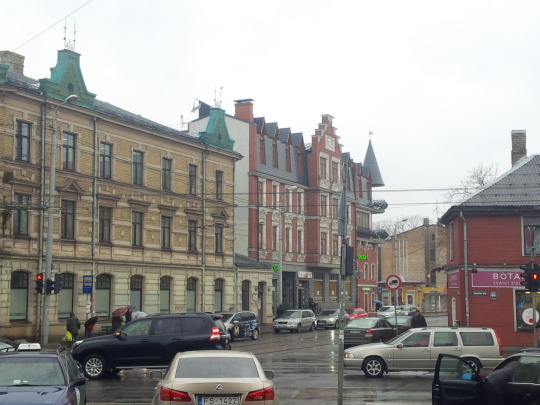
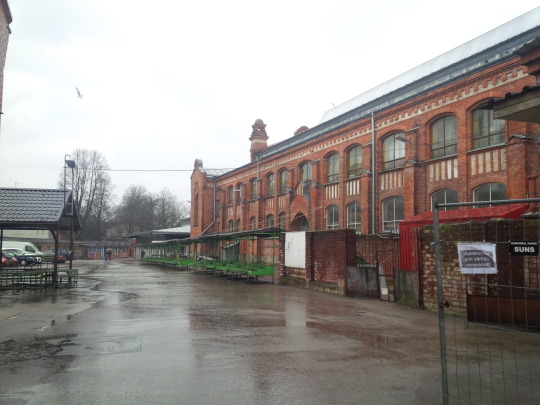
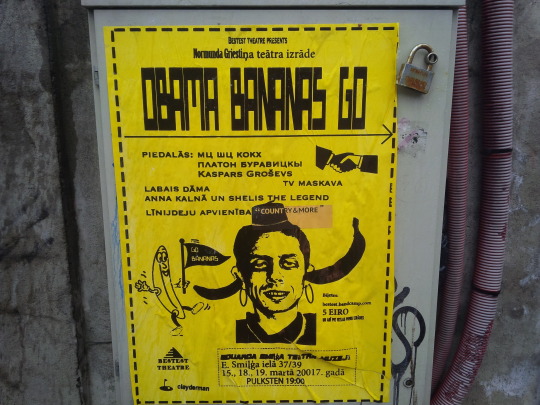
This “trash” frowny face was even sadder than the last one.
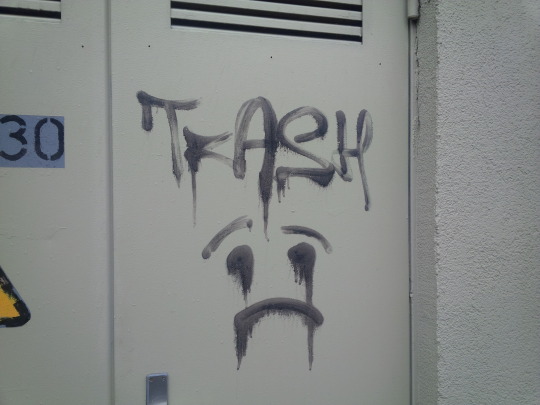
The interior of the market building was fairly typical for this region of Europe, but Konstantin told me that he much preferred this one to the more famous and impressive central market in Rīga's center due to its more intimate feel. The walls above the market stands were adorned with the coats of arms of Latvia's cities and towns, which was a nice touch. Luckily the upstairs balcony was open and we were able to get a nice view of the whole inside. There were some very nice looking meats, fruits, and vegetables, but we still had a lot to see and decided that carrying around perishables probably was not the best idea.


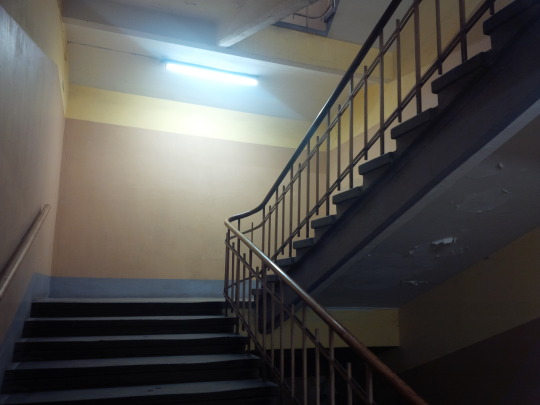
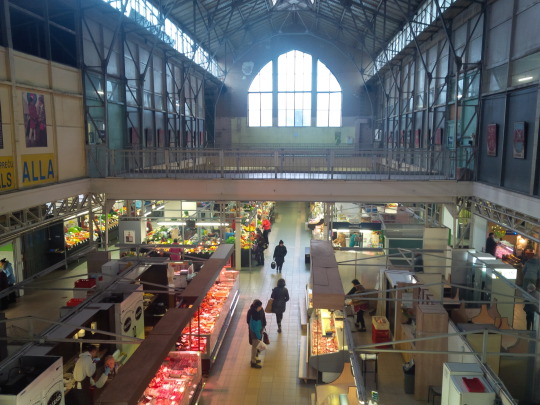
The stands and benches outside were emptier than usual due to the weather, but there were still a few people selling fresh flowers to passers-by. We continued a tiny bit further down Bāriņu iela to one location I had passed by many times but had never been able to get a closer look at: the Eduarda Smiļģa Teātra muzejs, the city's museum of theater. This former home of famed actor and director Eduards Smiļģis (1886-1966) is now run by the Latvian Academy of Culture as a space for exhibitions and live shows. The grounds of the building were gorgeous, but unfortunately we decided that we would have to save the museum itself for another day considering how wet we now were and how little time we had left to see the rest of the neighborhood.
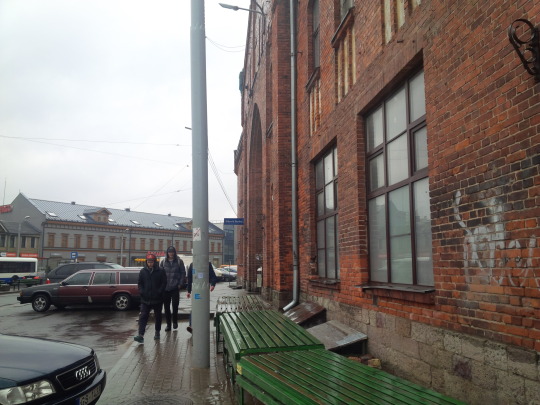

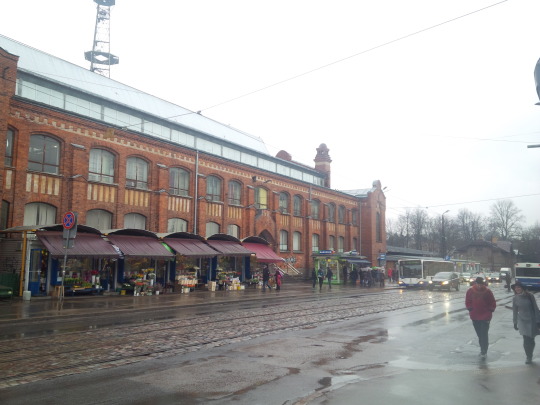
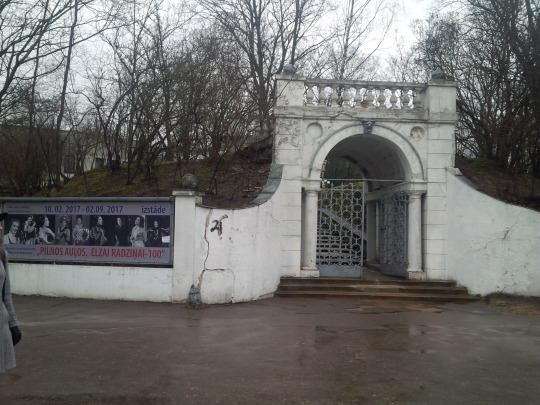
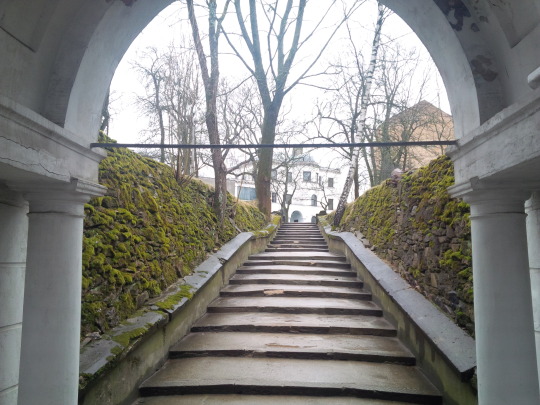



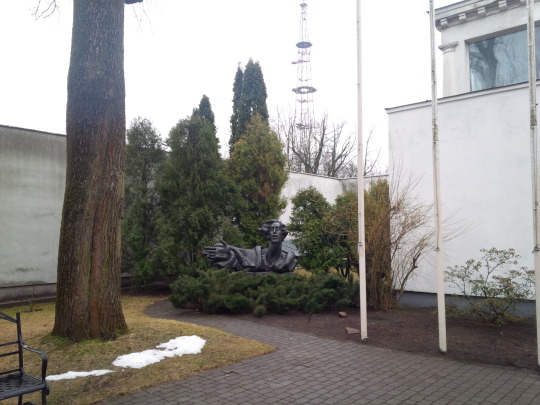
Līga wanted to see Svētā Alberta (St. Albert's), one of her favorite churches, so we headed towards it via a roundabout route past Māras diķis (Mara's pond). We started past the beautifully painted Rīgas Friča Brīvzemnieka pamatskola, one of the city's most historic elementary schools. The far less attractive concrete box across the street was Rīgas Pārdaugavas izpilddirekcija, home to a variety of government services available to those living on this side of the river. This style of building which looks brutalist to American or British eyes is incredibly common throughout the former Soviet Union for various municipal or education-related institutions. As we got closer to the park, we passed a few more wooden and brick buildings built before WWII as well as a few very modern constructions.

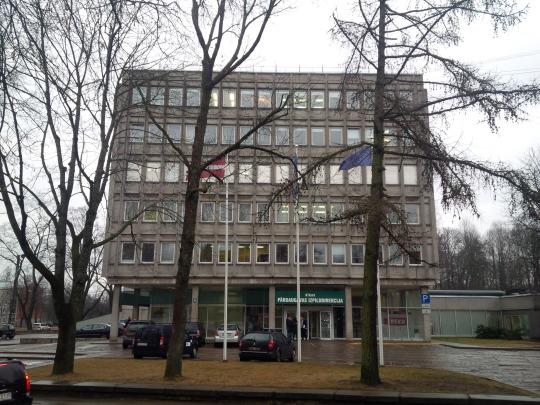


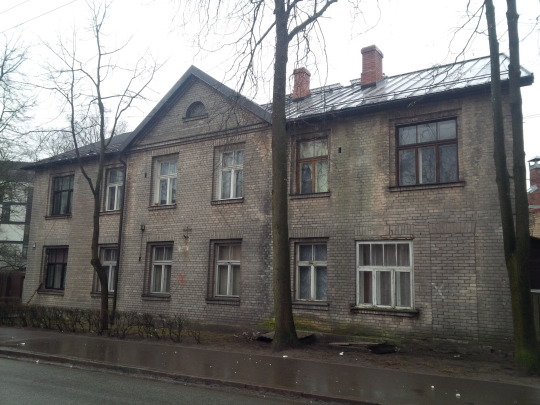


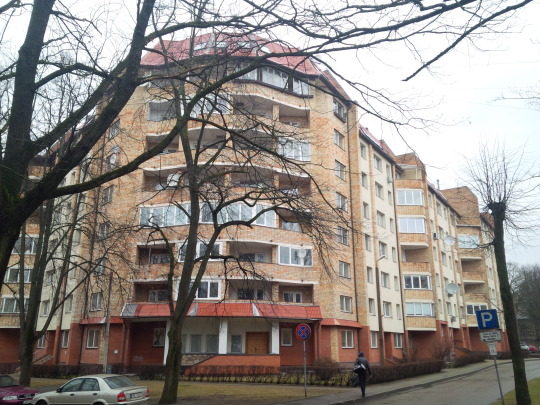
Right near the pond there was a small park with a hill formed from a split between Kokles iela and Mazā Nometņu iela. There wasn't any information that we could find about it, but it seemed like a natural extension of Arkādijas parks in Torņakalns on the other side of the road. The park seemed pretty well-maintained, and at the top of the hill there was a decent view of the surrounding area including the pond.





As you can see from the last picture, Māras diķis is lined on its eastern coast by a walled-off mansions. Thankfully, the entire circumference of the pond is accessible via a paved walking trail. The pond was used for mills all the way back to the 13th century, although the most recent mill was torn down in the 1920s. These days it's only used for recreational purposes, but no swimming is allowed.

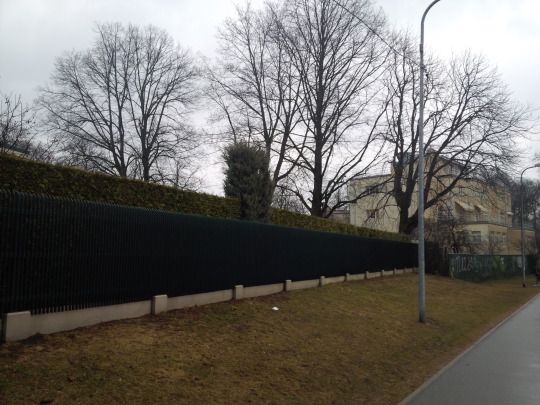
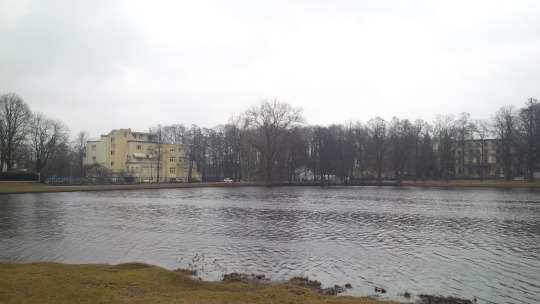


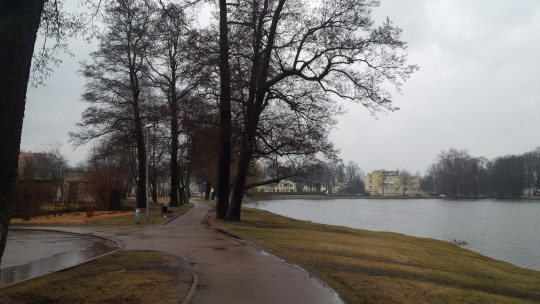
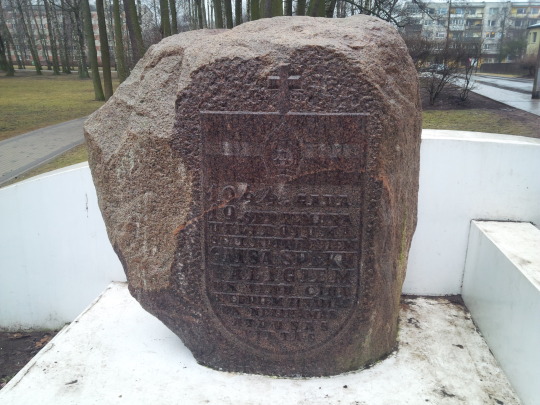
Having walked around the pond, we headed straight down Mārupes iela where there was a mix of residential buildings and student housing for Rīgas Stradiņa universitāte, the country’s most famous medical university named after famous Latvian surgeon Pauls Stradiņš. We also passed one of the city’s few Baptist churches, one of the “Coffee Tower” cafes which Konstantin mentioned tried to buy the water tower, and a Rimi.
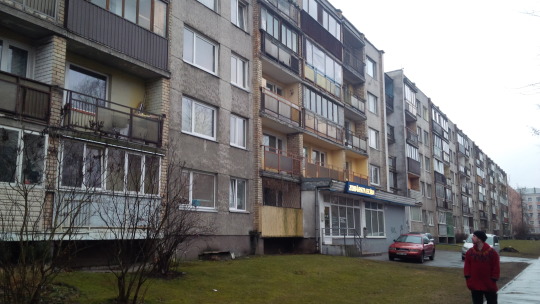
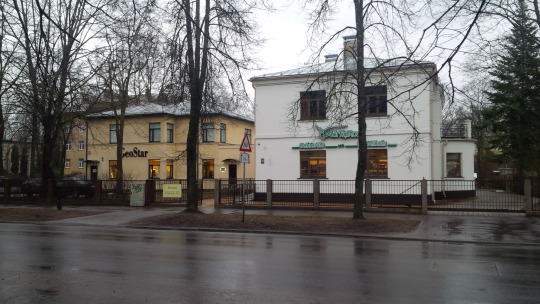
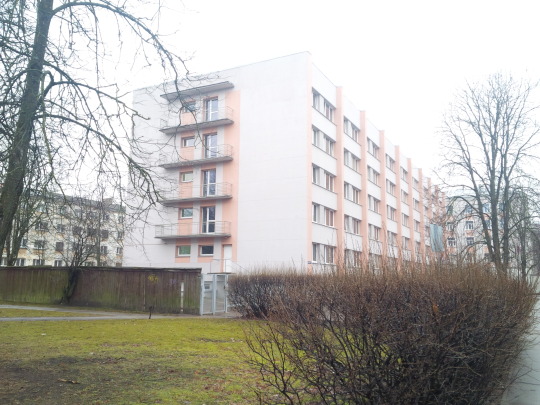
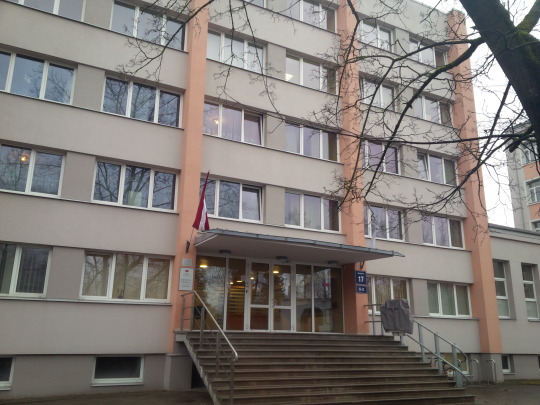


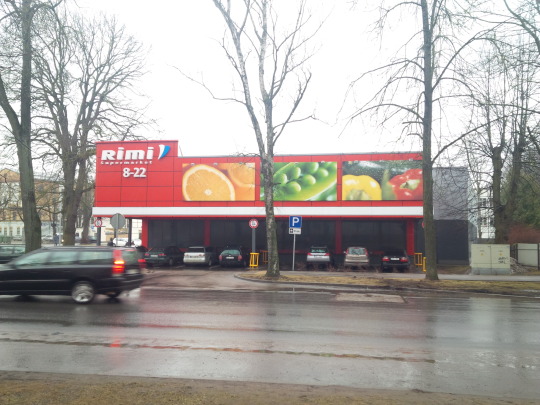
We turned left onto Leipājas iela, where we saw some graffiti that warned us: “beidz izdomāt melus” (stop making up lies). Within a few minutes we were standing outside of Sv. Alberta baznīca, an important part of Rīga’s Catholic community. Originally intended to be built in French Baroque style, starts and stops to the construction resulted in the somewhat unique final design. Across the street behind the brick wall was the many historic buildings on the campus of Stradiņa klīniskā universitātes slimnīca (the university hospital). Unfortunately we did not have the opportunity to explore the campus, but we were so wet and cold at this point that we were ready to take the bus to our final destination: Uzvaras Parks.




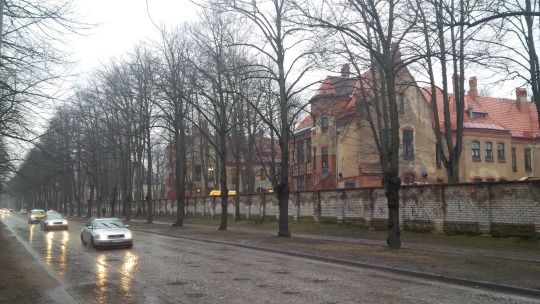
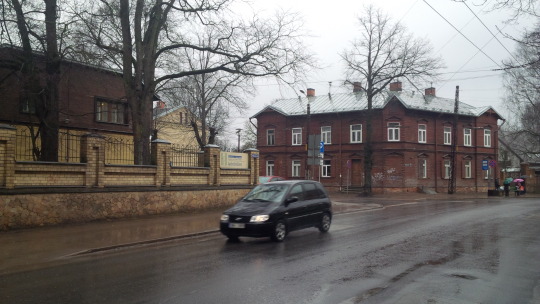
Since turning towards the market, our path had looked like this:
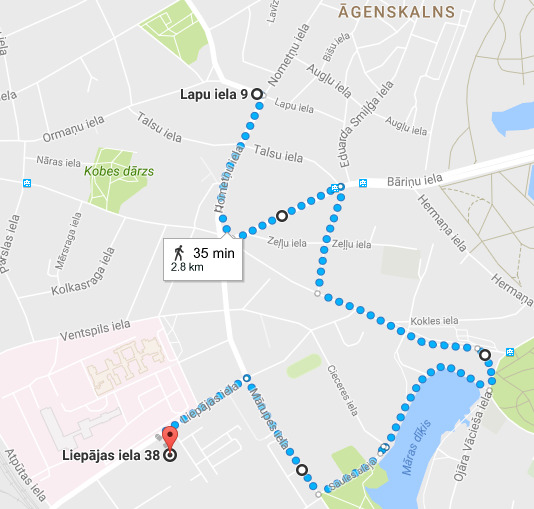
We got off at Slokas iela in front of Zelta Boulings, Rīga’s most popular bowling alley with some of the most surpisringly good pizza found in the city. We backtracked a bit down Uzvaras bulvaris to come to our final stop in the Āgenskalns and one of the city’s most controversial locations: Uzvaras piemineklis (Victory Memorial).

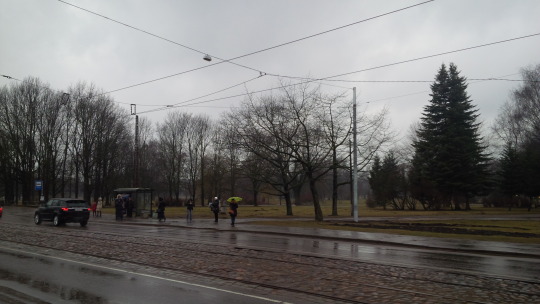

While the end of WWII and the defeat of the Nazis is celebrated throughout the world, many in Latvia (particularly ethnic Latvians) see the end of WWII as the beginning of the Soviet Union’s occupation of the country which included the forced deportations and murders of tens of thousands of Latvians. The monument was built in the early 1980s and is one of the most physically impressive sites in the entire country, but there have been many calls to demolish it as most other Soviet-era statues were at the re-establishment of Latvian independence. In fact, two ultra-nationalists even tried blowing the monument up in 1997, but ended up dying with the statue mostly unharmed. The site is especially important to the city’s ethnic Russian community which makes up nearly a majority of Rīga’s residents, many of whom had family who fought proudly to defend their country against the Nazi invaders. Many ethnic Russians feel alienated and left behind by the Latvian government's policies since 1991 regarding citizenship and language, and removing the statue would inevitably cause significant tension. For the foreseeable future the statue will remain as a divisive symbol which means many things to many people, and I will write more about the issue for the upcoming May 8th/9th celebration of V-E Day. What is undeniable, however, is that the Soviets knew how to make impressive and awe-inspiring statues.





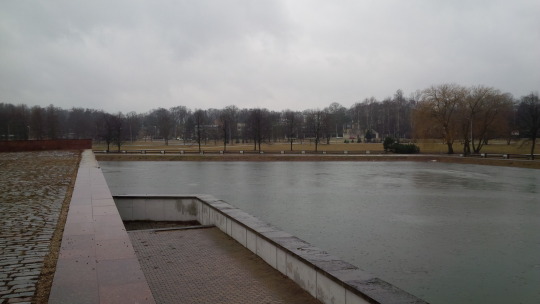


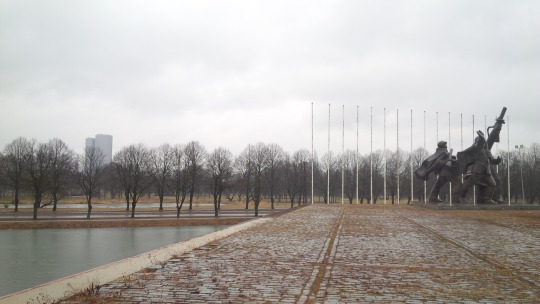
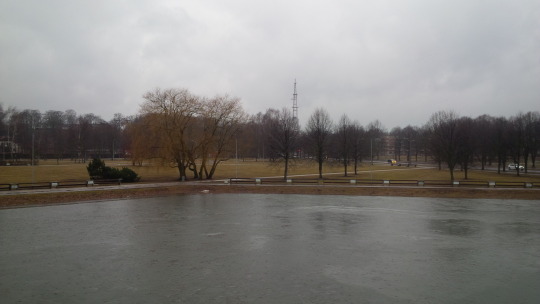
The final part of Āgenskalns that we skipped over was the rest of Uzvaras parks, but we were so cold and wet by now that we decided to go home. Plus, the rain was so heavy by now that the pictures we would have taken wouldn’t have done justice to the beautiful park. Instead, I will cheat with a few pictures we took of the park from last spring.



I hope that these rainy and dark pictures haven’t discouraged you, because visiting Āgenskalns is an absolute no-brainer regardless of your personal interests. While I usually recommend visiting certain neighborhoods to certain people for various reasons, Āgenskalns is one of the only ones I can suggest without any hesitation or second thoughts. If you’ve been in Rīga for any significant amount of time I’m sure you’ve alresdy spent some time here, but if you somehow haven’t yet wandered across the bridge to Pārdaugava then it’s time to come and visit.
A few random observations:
While most people I know who have lived outside of Rīga’s center have told me that they don’t do much in those neighborhoods aside from living and do most other things in the center, most of the people I know who live in Āgenskalns spend a significant amount of their time there. This is unsurprising considering how much there is to do and see here, but it really almost feels like a separate city with a somewhat different feel to it.
That being said, Līga and I have spent surprisingly little time in Āgenskalns. Although there’s so much to do, I have usually seen it from the windows of busses going to and back from work at the LU Pedagogy Faculty in Imanta. From Ķengarags it takes just a tiny bit too long to get to compared to the center where you can find almost anything that Āgenskalns has, but if I already lived in Pārdaugava I’m sure I’d spend more time here than time across the bridge.
Although we thought that winter had just about completely passed at this point in mid-March, we woke up this morning in mid-April to fairly heavy snowfall. To say that winter/spring 2017 has been a curveball would be quite an understatement.
And that’s it for now. I apologize that this post has been a bit longer than the others, but there is just so much to show and talk about in Āgenskalns that I didn’t want to leave anything out. Also a huge special thanks to Konstantin for contributing so much historical information about the neighborhood and its buildings, another reason why this post is a bit longer than the others. He’s planning on coming with us more regularly on our walks through the neighborhoods, and he might contribute some other posts in the future about urban exploration and other Rīga-related topics. Until next time, let’s hope that spring will soon finally stick around!
Nākamā Pietura: Atgāzene!
(Edit: Thanks to Māris Goldmanis from the fantastic Latvian History blog who wrote in with additional information a bout the state archives and the TV tower after the post was first published)
#agenskalns#Āgenskalns#riga#Rīga#Latvia#Latvija#soviet architecture#architecture#art nouveau#latvian history#old riga#Rīgas pilsēta#Vecrīga#Vecriga#water tower#city exploration#urban exploration#urbanexploration#urban explorers#urbandecay#abandoned buildings#abandoned places#Рига#Pārdaugava#riga stradiņš university#z-towers#uzvaraspiemeneklis#uzvarasparks#Латвия#public transit
2 notes
·
View notes
Text
breakinglv
🇱🇻 Vilciens #Zasulauks #Rīga #Latvija notrieca uz sliedēm sievieti, kur no gūtām traumām gājusi bojā. https://t.co/kOOHjBIsWK
— BreakingLV (@breakinglv) May 11, 2020
0 notes
Text
breakinglv
Avārija Jūrmalas gatvē #Zasulauks #Rīga #Latvija pirms krustojuma ar Dzirciema ielu. Centra virzienā veidojās #sastrēgums. Foto: @alise_bi pic.twitter.com/YcyLTrYWue
— BreakingLV (@breakinglv) November 12, 2019
0 notes
Text
breakinglv
Avārija Jūrmalas gatvē #Zasulauks #Rīga #Latvija pirms krustojuma ar Dzirciema ielu. Centra virzienā veidojās #sastrēgums. 📸 Jessica Kravchuk pic.twitter.com/cPKlxYXdzC
— BreakingLV (@breakinglv) November 12, 2019
0 notes
Text
breakinglv
Avārijas dēļ Jūrmalas gatvē pie Botāniskā dārza #Zasulauks #Rīga #Latvija, kavējas 1. tramvaja kustība. 📷 @sandradiezina pic.twitter.com/gzgNgGjH01
— BreakingLV (@breakinglv) February 22, 2019
0 notes
Text
breakinglv
Vakar vakarā Jūrmalas gatves un Dzirciema ielas krustojumā #Zasulauks #Rīga #Latvija autovadītājs iebrauc ierobežojošās barjerās. Pēc avārijas mēģināja pamest CSN vietu, bet aculiecinieki viņu apturēja. 📷 Jeļena Vilcāne pic.twitter.com/lXCc3wfUx7
— BreakingLV (@breakinglv) February 17, 2019
0 notes